オーストラリア・ニュージーランドの鉄道を紹介します!
AUandNZ Railfan
Australia and New Zealand Railfan

ポートランドケーブルトラム
Portland Cable Tram
The Portland Cable Tram is a tourist tram in Portland, a city about 360 km west of the Victorian capital Melbourne. It opened on 2 March 2002. Unusually for an Australian heritage railway, it operates 364 days a year, excluding Christmas Day.
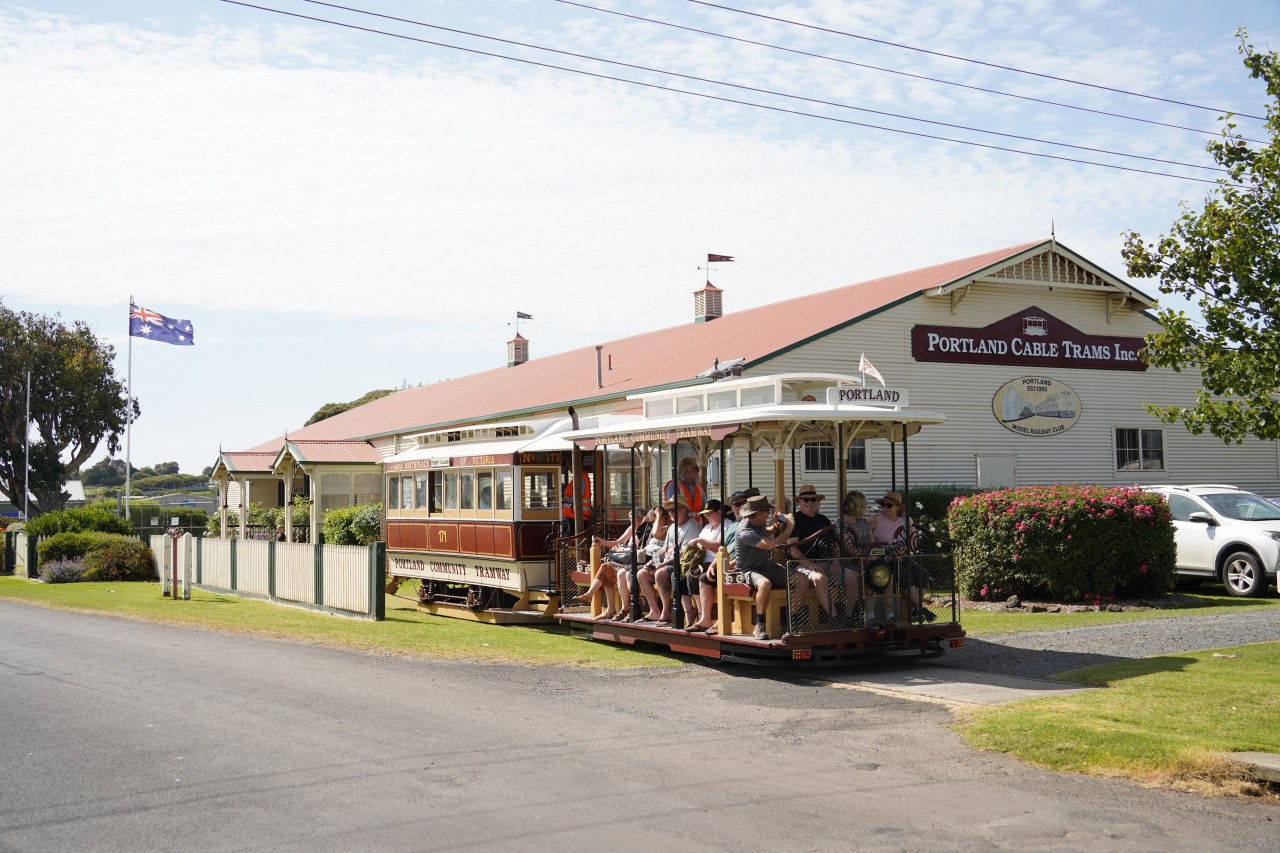
観光地であるポートランドを活性化させるために、ポートランドケーブルトラムは建設されました。
ポートランドケーブルトラムはかつてメルボルンで電化前に活躍したケーブルトラムの車両(復元車両を含む)に乗車することができます。
ケーブルトラムと名乗っていますが、実際はディーゼルエンジンを動力源としています。
かつてのメルボルン同様にケーブルを動力とすることも考えられましたが、地下に這わせたケーブルを絶え間なく動かすことが難しく、
実現には至りませんでした。
The Portland Cable Tram was built to revitalise Portland as a tourist destination.
The Portland Cable Tram offers passengers the opportunity to ride on cable tram vehicles (including restored vehicles) that once operated in Melbourne prior to electrification.
Although they call themselves cable trams, they are actually powered by diesel engines.
The idea was to use cables to power the trams, as in Melbourne in the past, but it was difficult to keep the cables crawling underground and moving constantly, It never came to fruition.
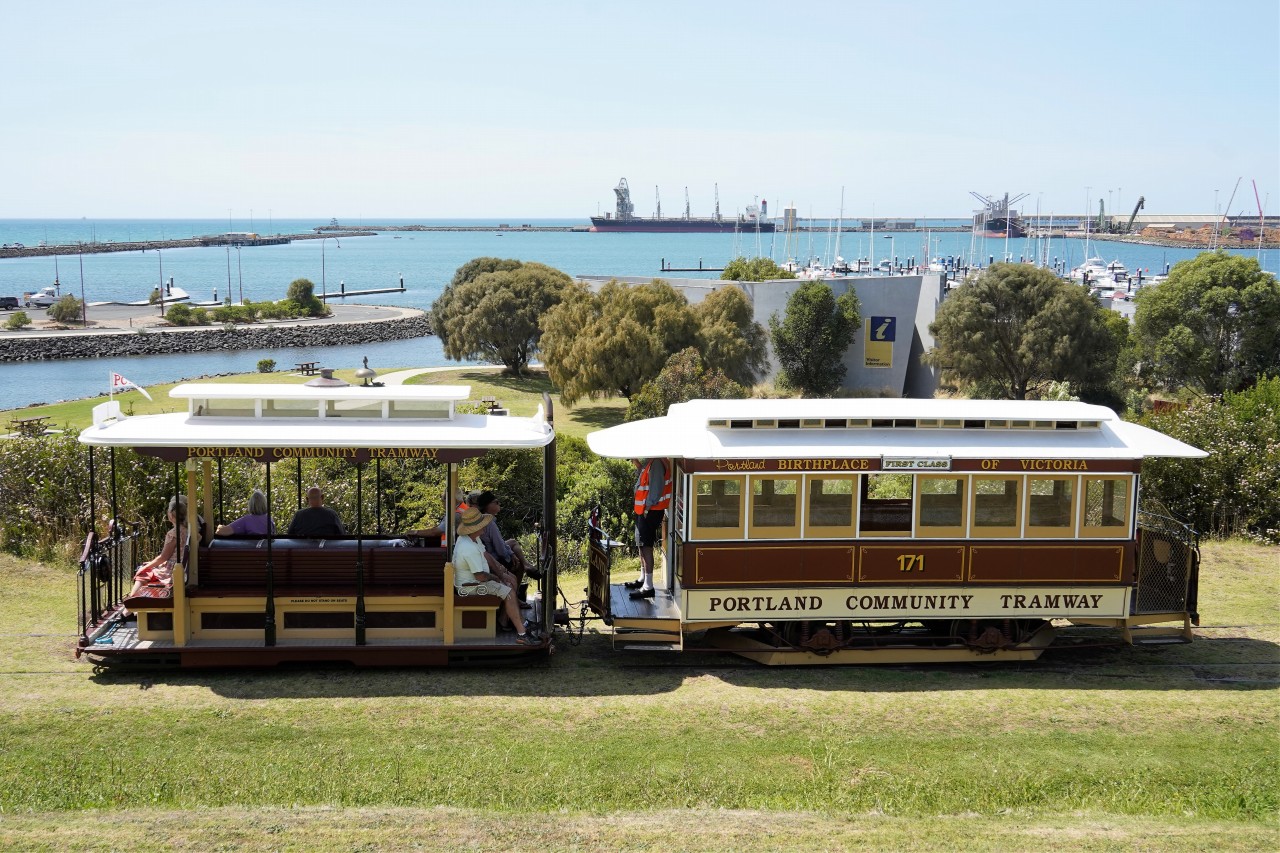
ポートランドのケーブルトラムはグリップカー(左)とサルーンカー(右)のペアで運行しています。
本来のケーブルトラムはグリップカーが地下を動くケーブルを掴むことで車両が動きます。
ポートランドでは復元コピーのグリップカーが2両活躍し、動力がディーゼルエンジンであることを除けばメルボルンのケーブルトラムを完全再現しています。
サルーンカーはグリップカーと連結することで走る、動力のない客車です。
ポートランドのサルーンカーはNo171とNo95が活躍しています。
どちらのサルーンカーも1886年に製造され、メルボルンのケーブルトラムで実際に使用されていました。
Portland's cable trams operate in pairs of grip cars (left) and saloon cars (right).
In the original cable tram, the cars are moved by the grip cars gripping the cables that move underground.
Two reconstructed copies of the Grip Cars are in service in Portland and are a perfect replica of the Melbourne cable tram, except that they are powered by diesel engines.
Saloon cars are unpowered carriages that run when coupled to a grip car.
The Portland saloon cars in service are No 171 and No 95.
Both saloon cars were built in 1886 and were actually used on the Melbourne cable trams.
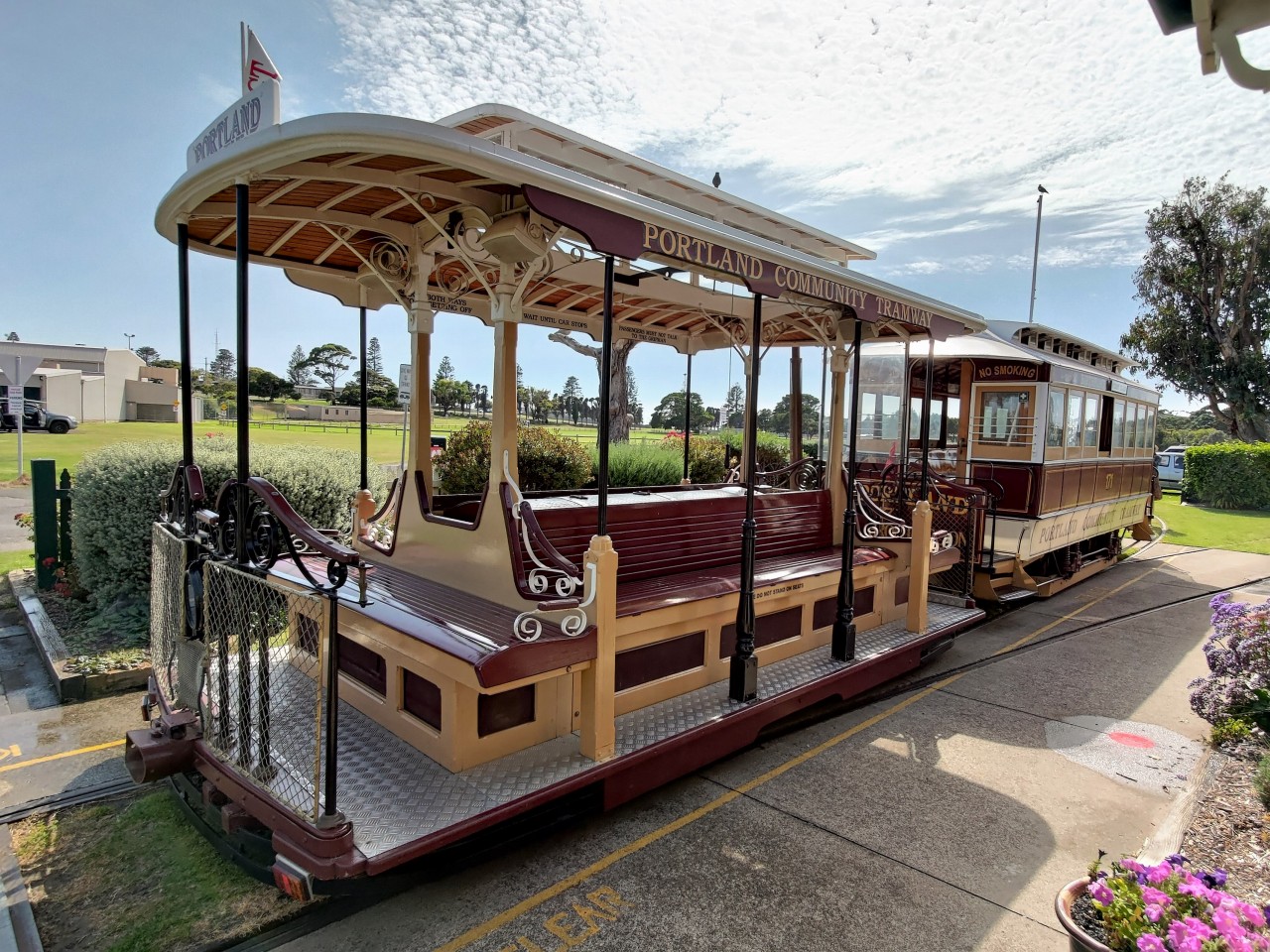
メルボルンのケーブルトラムを再現したグリップカー。
車両中央にディーゼルエンジンが搭載されています。
車両に壁は無く、木製ベンチが車両の外側に向かって配置されています。
ケーブルトラム全盛期は風雨に晒されるグリップカーはあまり人気がなかったようです。
現在は勿論、先頭のベンチが一番人気です。
Grip car reproduction of a Melbourne cable tram.
The diesel engine is mounted in the centre of the vehicle.
The car has no walls and wooden benches are positioned towards the outside of the car.
In the heyday of cable trams, grip cars exposed to the wind and rain were not very popular.
Today, of course, the benches at the front are the most popular.
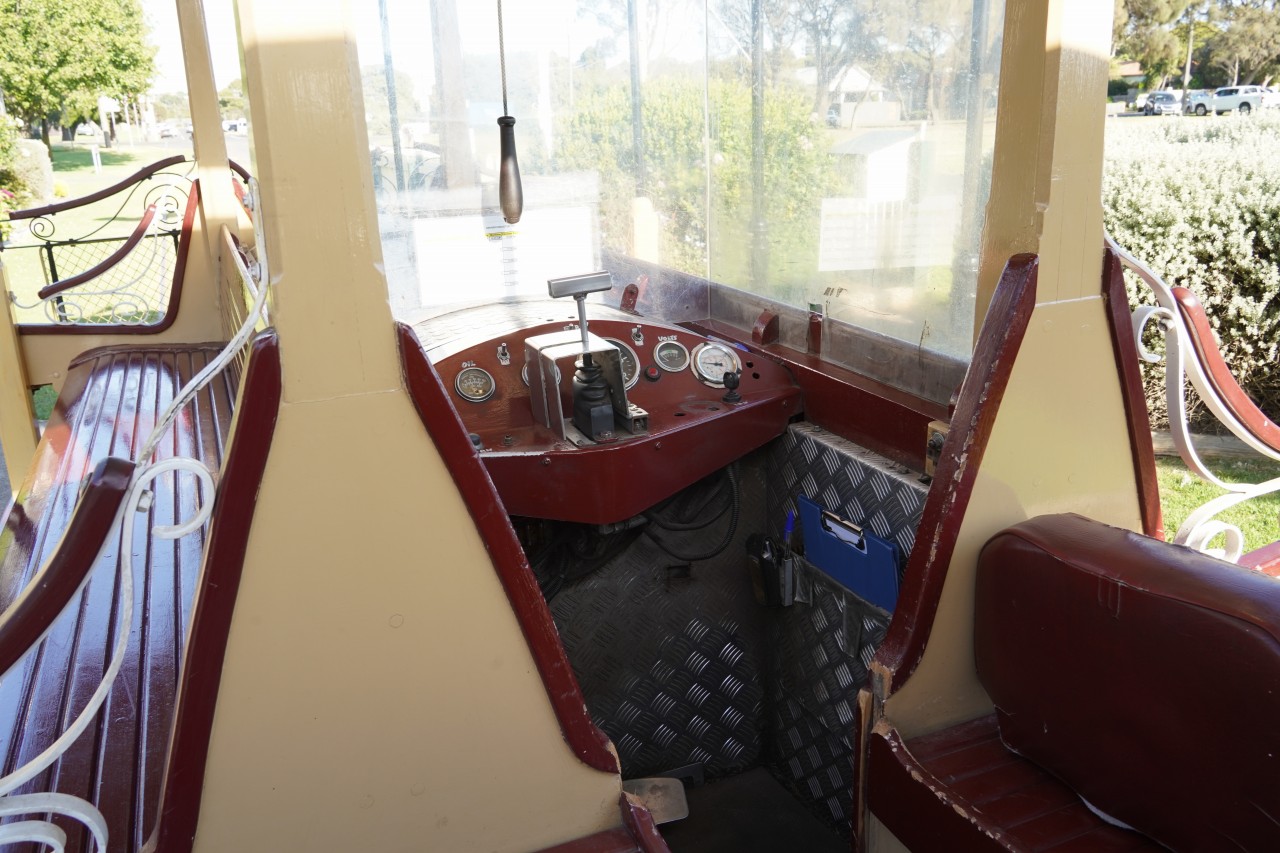
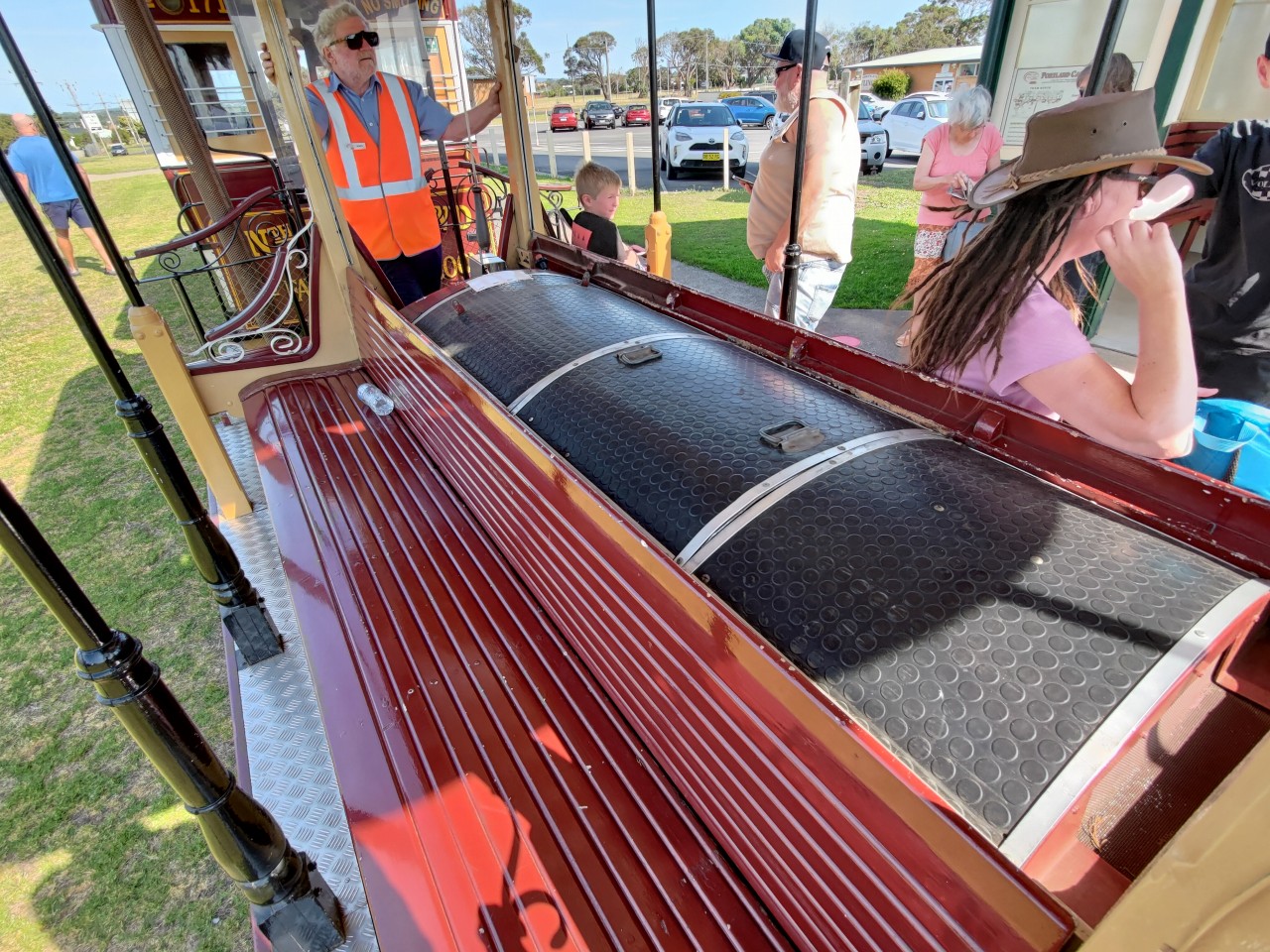
車両中央にある運転台とディーゼルエンジン。
ケーブルトラムを名乗っていますが、実際はディーゼルトラムです。
ケーブルトラムはこの場所に地下ケーブルを掴んだり離したりする装置があり、動き続けるケーブルの力で車両を走らせていました。
Driver's cab and diesel engine in the centre of the vehicle.
Although it calls itself a cable tram, it is actually a diesel tram.
Cable trams had a device at this location to grab and release the underground cable, and the vehicle was driven by the power of the cable, which kept moving.
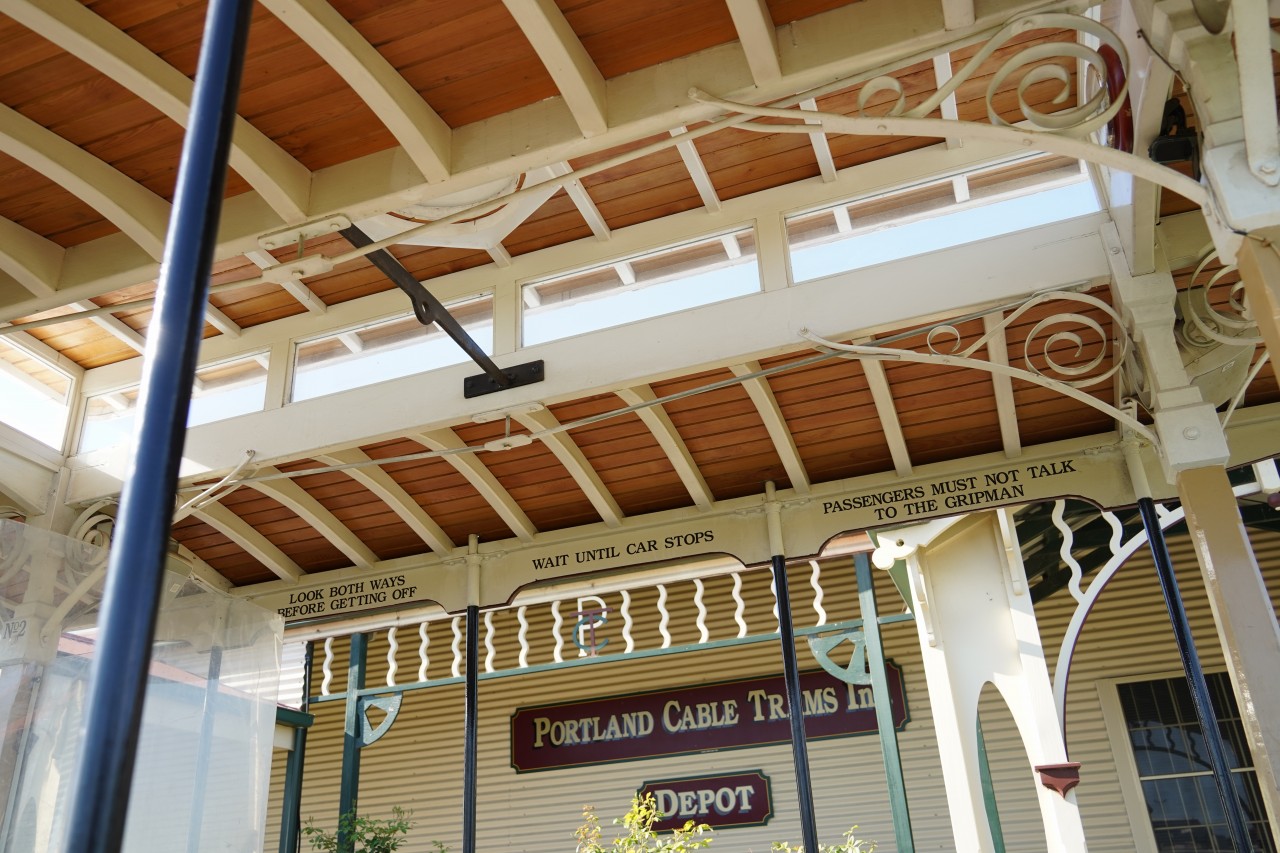
車両はダブルルーフ構造になっており、車内は非常に明るく解放的です。
そもそも車両には壁がないため採光は十分のはずですが、デザインにもこだわりが感じられます。
The vehicle has a double roof structure, which makes the interior very bright and liberating.
To begin with, the vehicle has no walls, so lighting should be sufficient, but the design is also very well thought out.
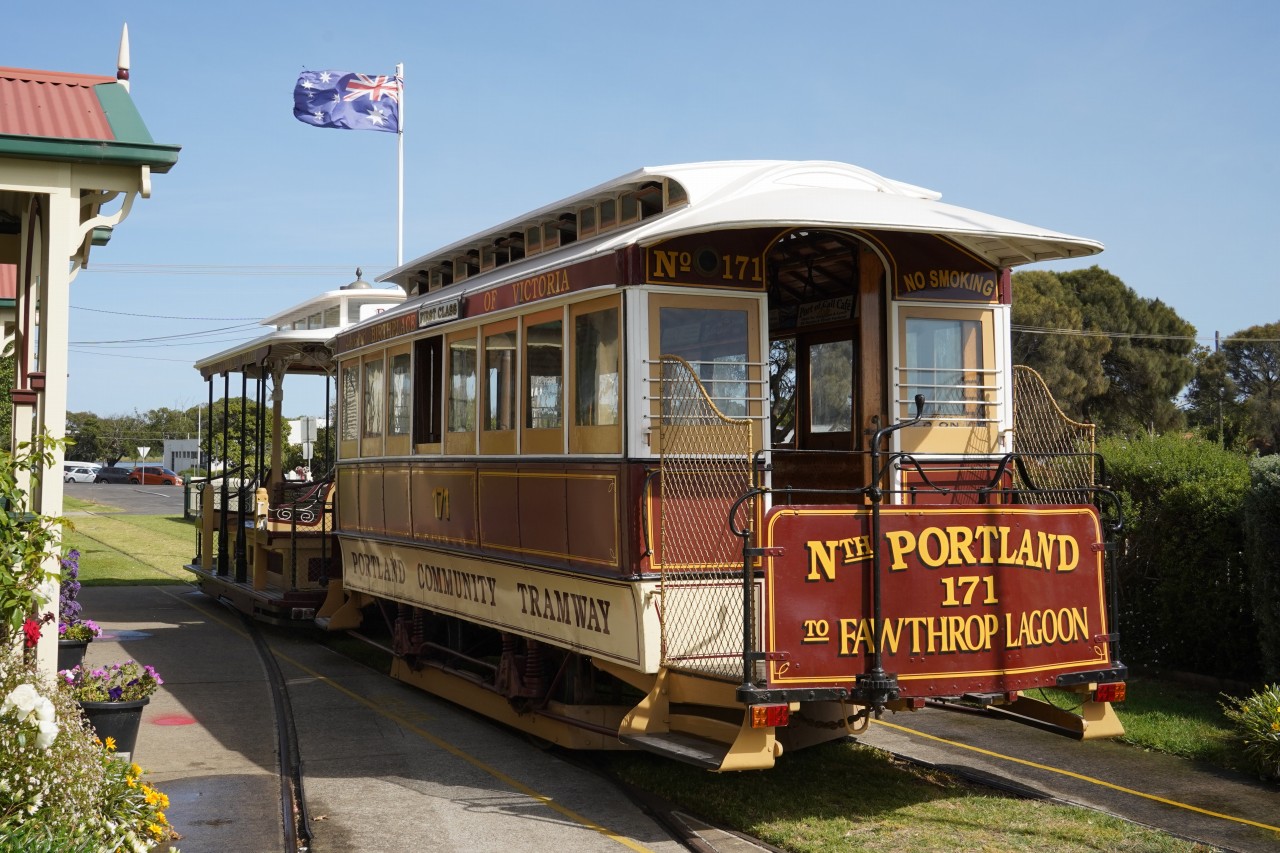
サルーンカーNo.171は1886年に製造され、1928年までメルボルンのクリフトンヒル線で使用されていました。
その後は個人所有となり、ポートランドケーブルトラムに永久貸与されています。
メルボルンのケーブルトラム運行開始100周年を記念して修復されました。
Saloon car No 171 was built in 1886 and used on the Clifton Hill line in Melbourne until 1928.
It was then privately owned and permanently leased to Portland Cable Trams.
It was restored to commemorate the centenary of Melbourne's cable tram service.
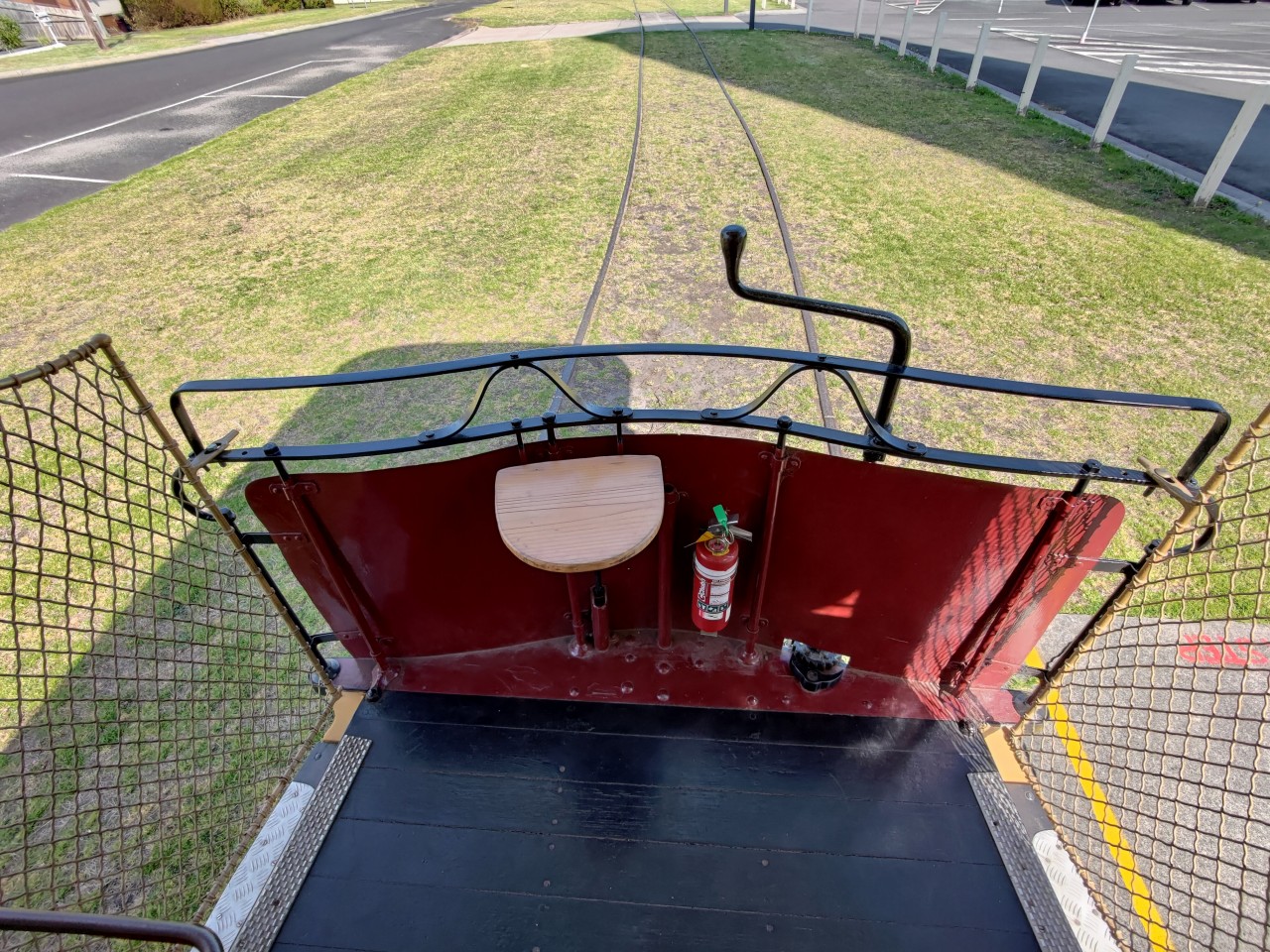
サルーンカーのデッキは非常にシンプルです。
動力を直接制御することはできず、ワイヤーハンドブレーキがあるのみです。
The deck of a saloon car is very simple.
There is no direct control of power, only a wire handbrake.
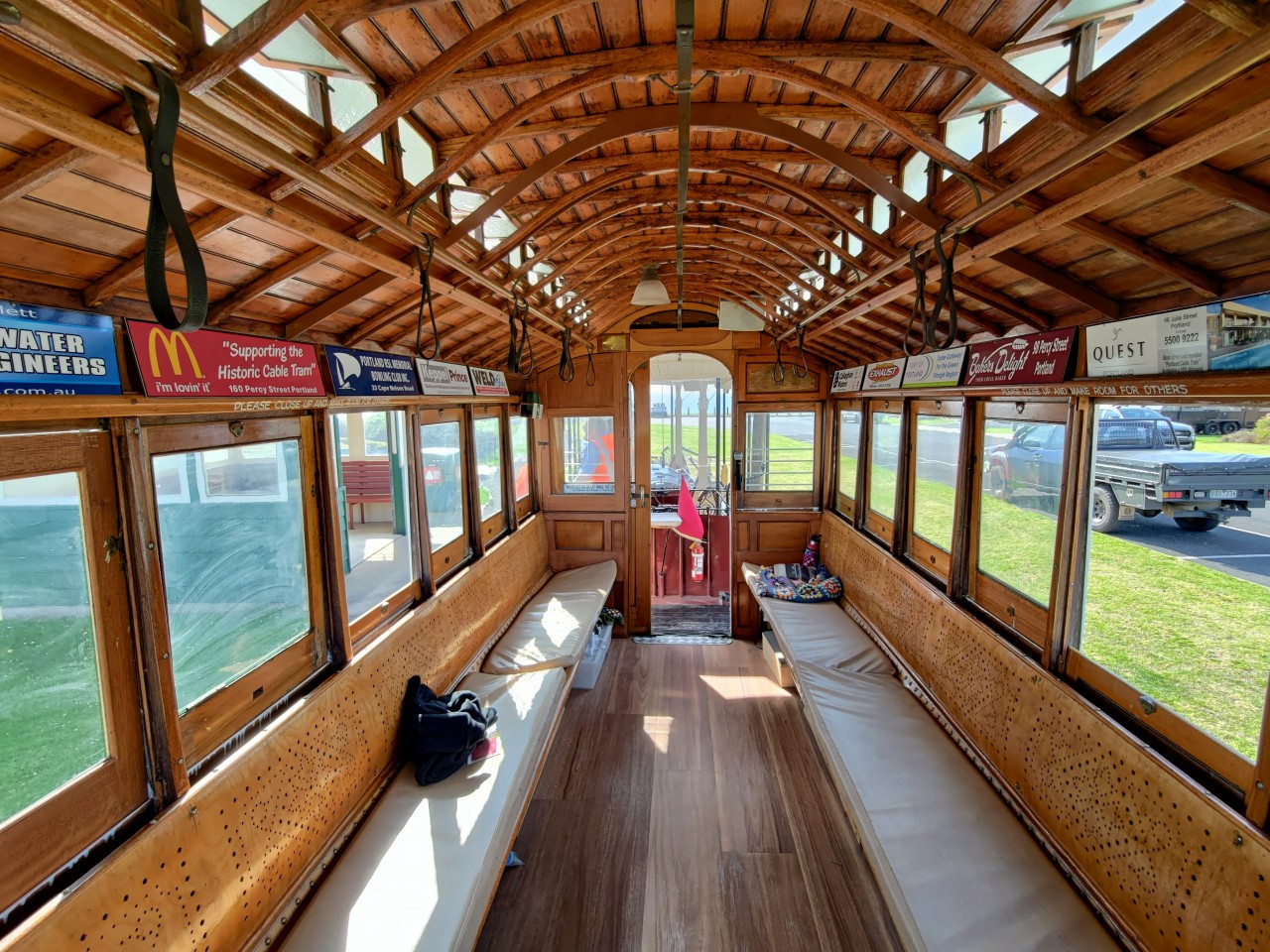
サルーンカーNo.171の車内。ダブルルーフ構造で明るい車内のロングシート車両です。
デッキとの間に仕切り扉があり、悪天候でも乗客は風雨に晒されることはありません。
ケーブルトラム全盛期は快適に過ごせるサルーンカーの方が人気があったようです。
Interior of saloon car No. 171. This bench seat car has a double roof construction and a bright interior.
There is a partition door between it and the deck, so passengers are not exposed to the elements in bad weather.
In the heyday of cable trams, saloon cars were more popular for their comfort.
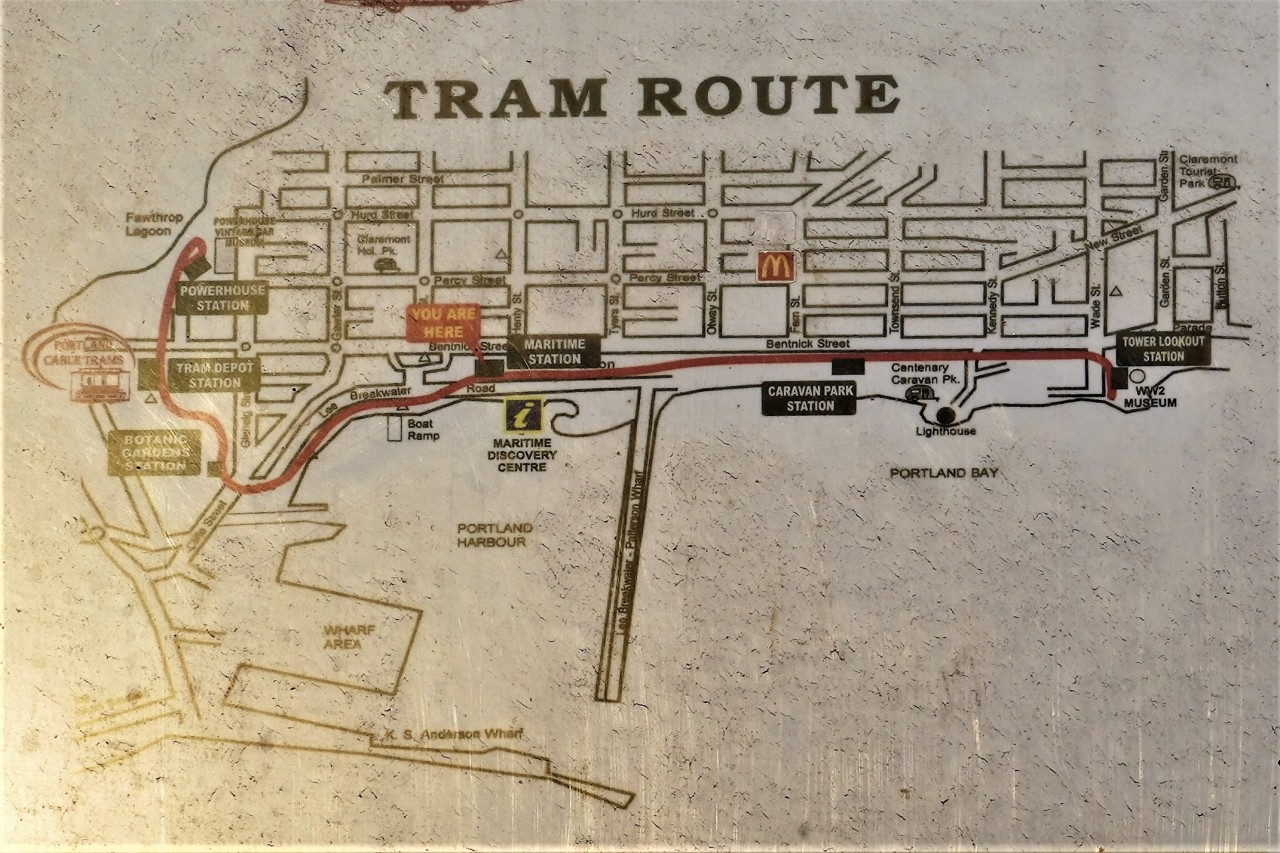
ポートランドケーブルトラムの路線図。路線長は3.7㎞です。
起点のパワーハウスミュージアムはバルーンループ、終点のタワールックアウトはシャンティングトライアングルエンドが設置され、常にグリップカーが先頭を走る路線構造になっています。
Portland Cable Tram route map. The route length is 3.7 km.
The route structure is always headed by a grip car, with a balloon loop at the Powerhouse Museum at the starting point and a chanting triangle end at the Tower Lookout at the end of the line.
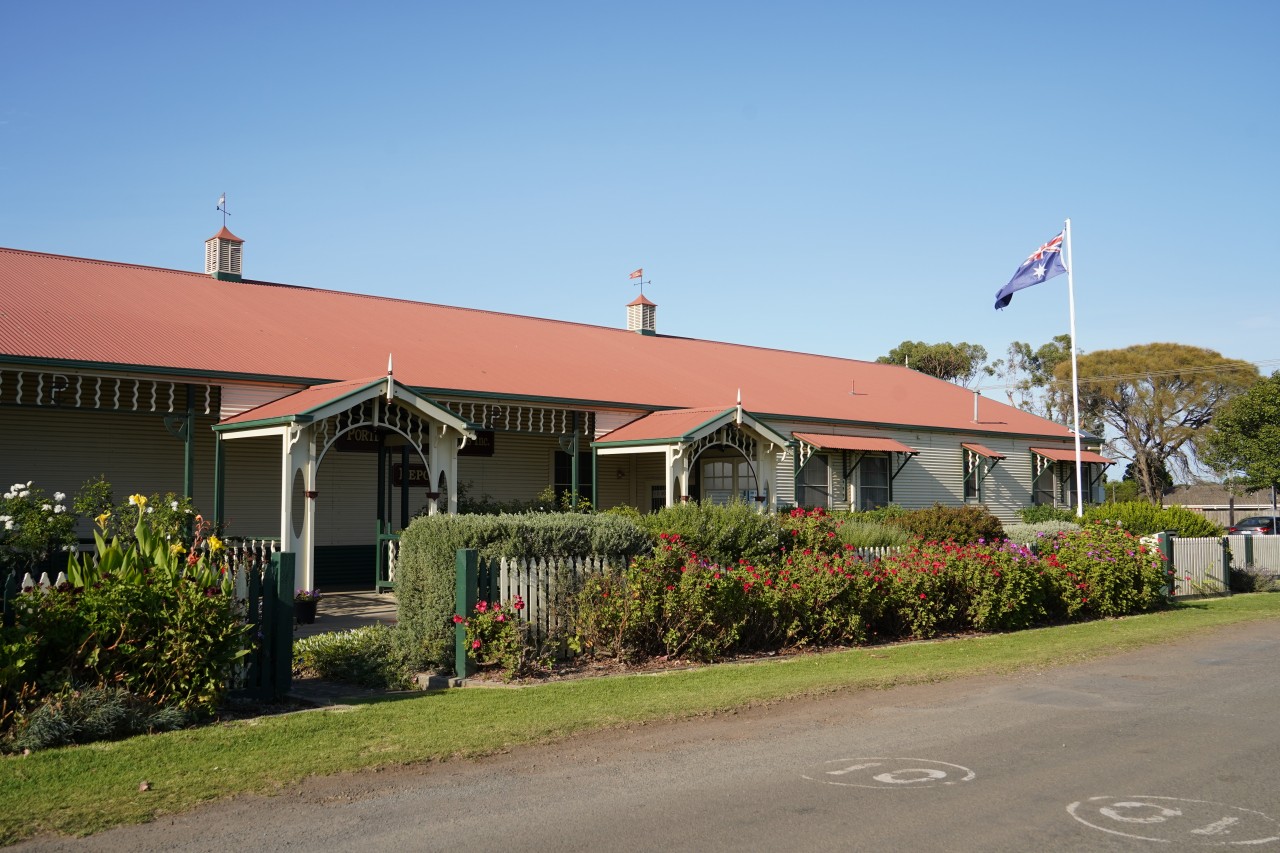
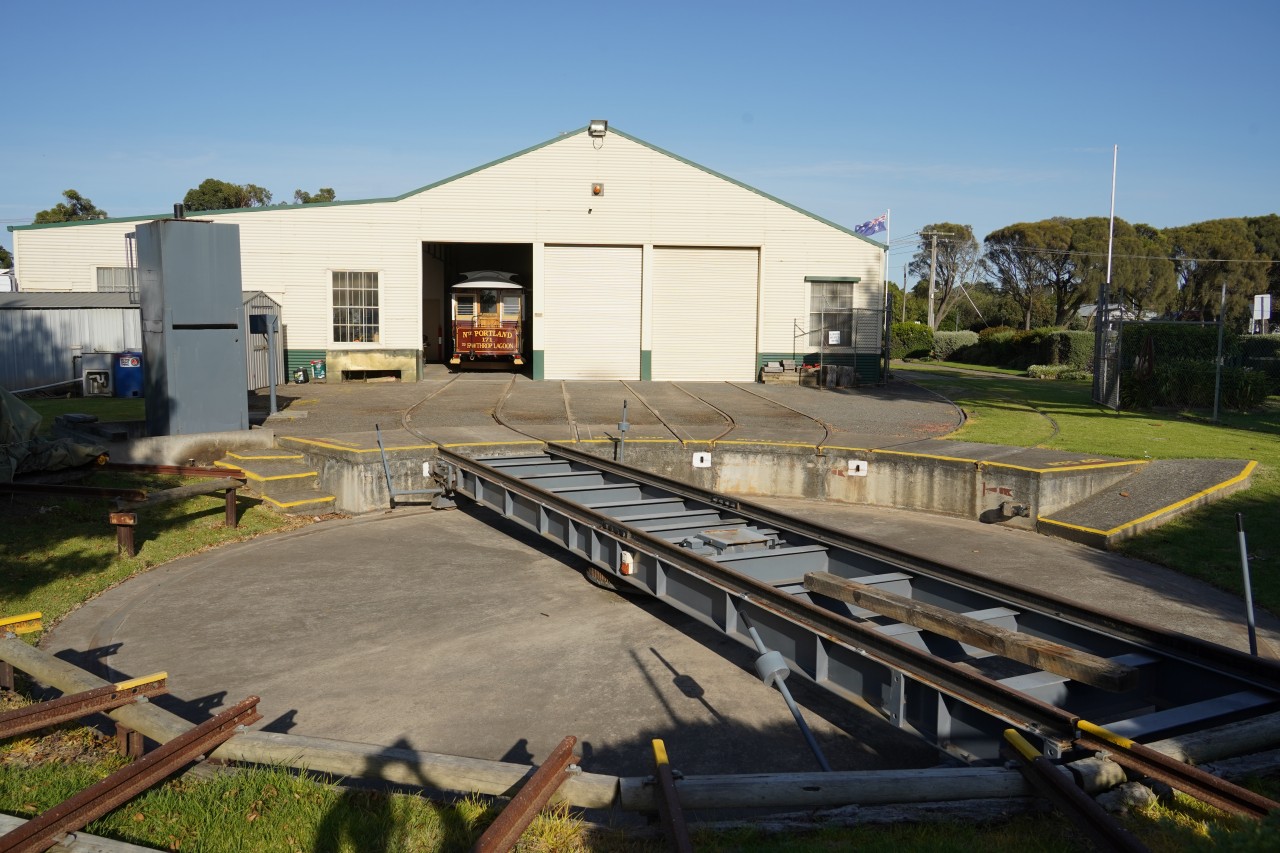
トラムデポ駅は運行上の始発駅です。チケットブースや博物館、車両点検の車庫が一体となっています。
本線と車庫は直接繋がっておらず、ターンテーブルを使用します。
ポートランドケーブルトラムはこの駅から1日5回のサービスがあります。すぐ隣のパワーハウスミュージアムのループで折り返しをするため、
全区間乗りとおす場合はトラムデポ駅は上下車を含め3回通ることになります。
Tram depot station is the first station on the operation. It combines a ticket booth, a museum and a depot for vehicle inspection.
The main line and the depot are not directly connected to the depot and use turntables.
The Portland Cable Tram has five services a day from this station. It makes a turnaround at the Powerhouse Museum loop immediately next to the station,
so if you ride the entire route, the tram depot station will be passed three times, including up and down trains.
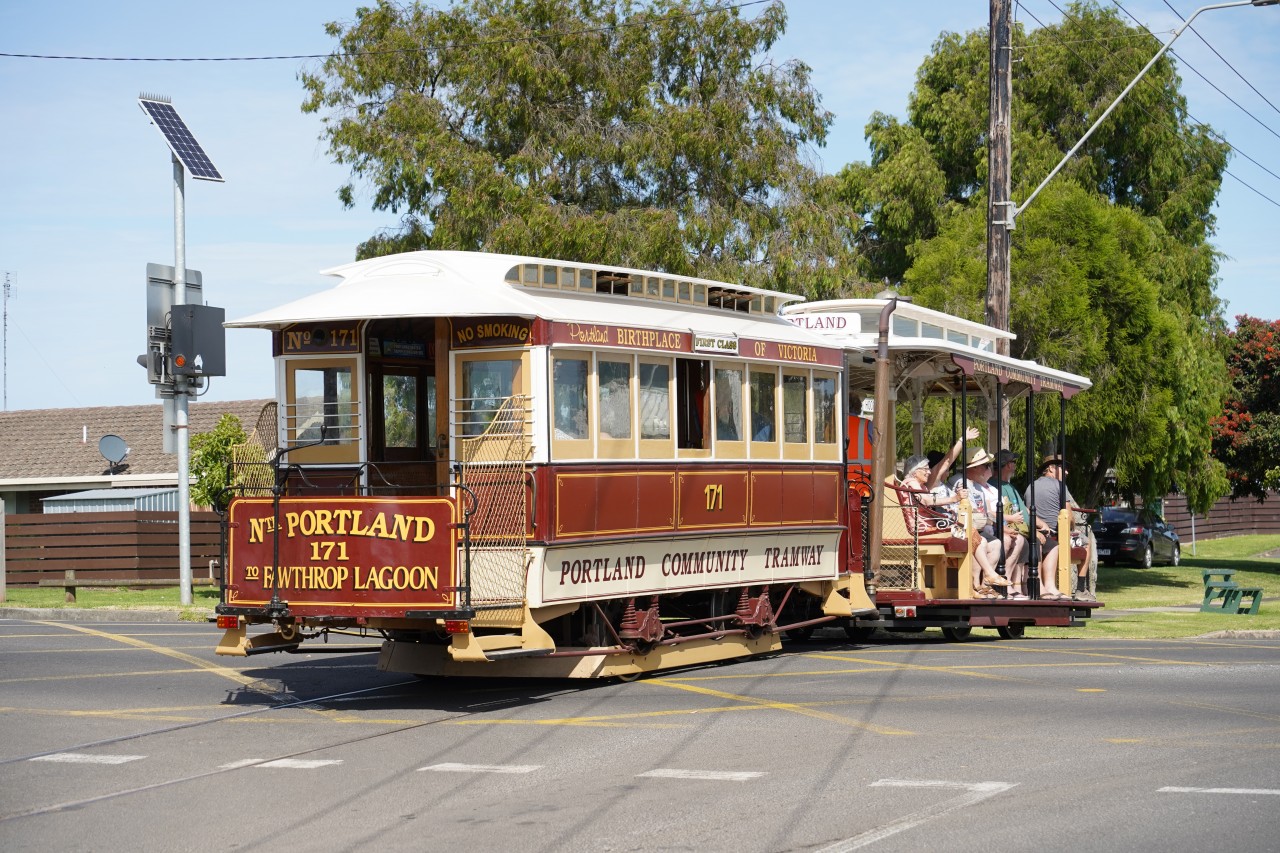
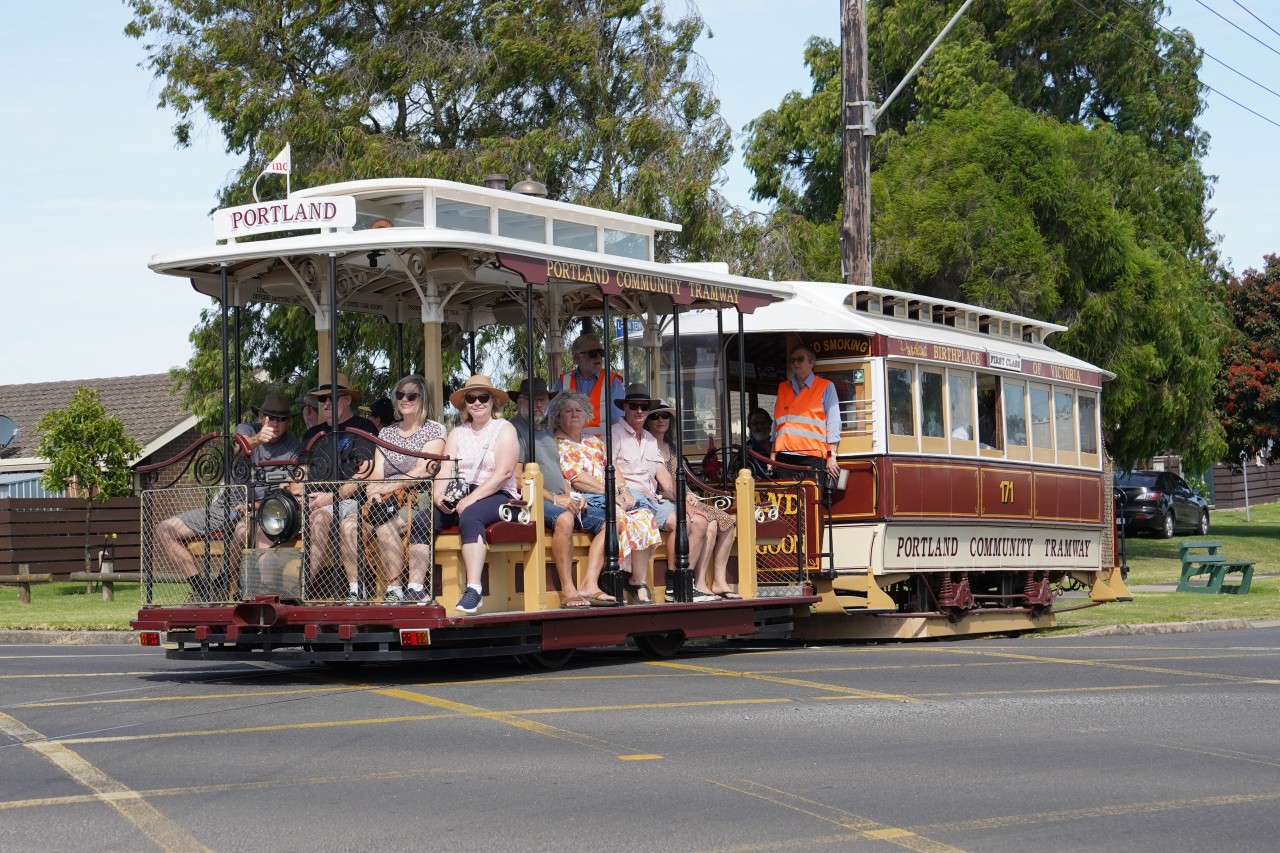
トラムデポ駅を発車し、最初の踏切を横断します。
すぐにパワーハウスミュージアム駅のバルーンループで折り返すため、程なくしてグリップカーを先頭に再び通過します。
そのためこの踏切ではサルーンカーとグリップカーの両方を順光で手軽に撮影できます。
The tram departs from Tram Depot station and crosses the first level crossing.
It soon turns back at the balloon loop at Powerhouse Museum Station and shortly afterwards passes through again with the grip cars in the lead.
This crossing therefore makes it easy to photograph both saloon and grip cars in good light.
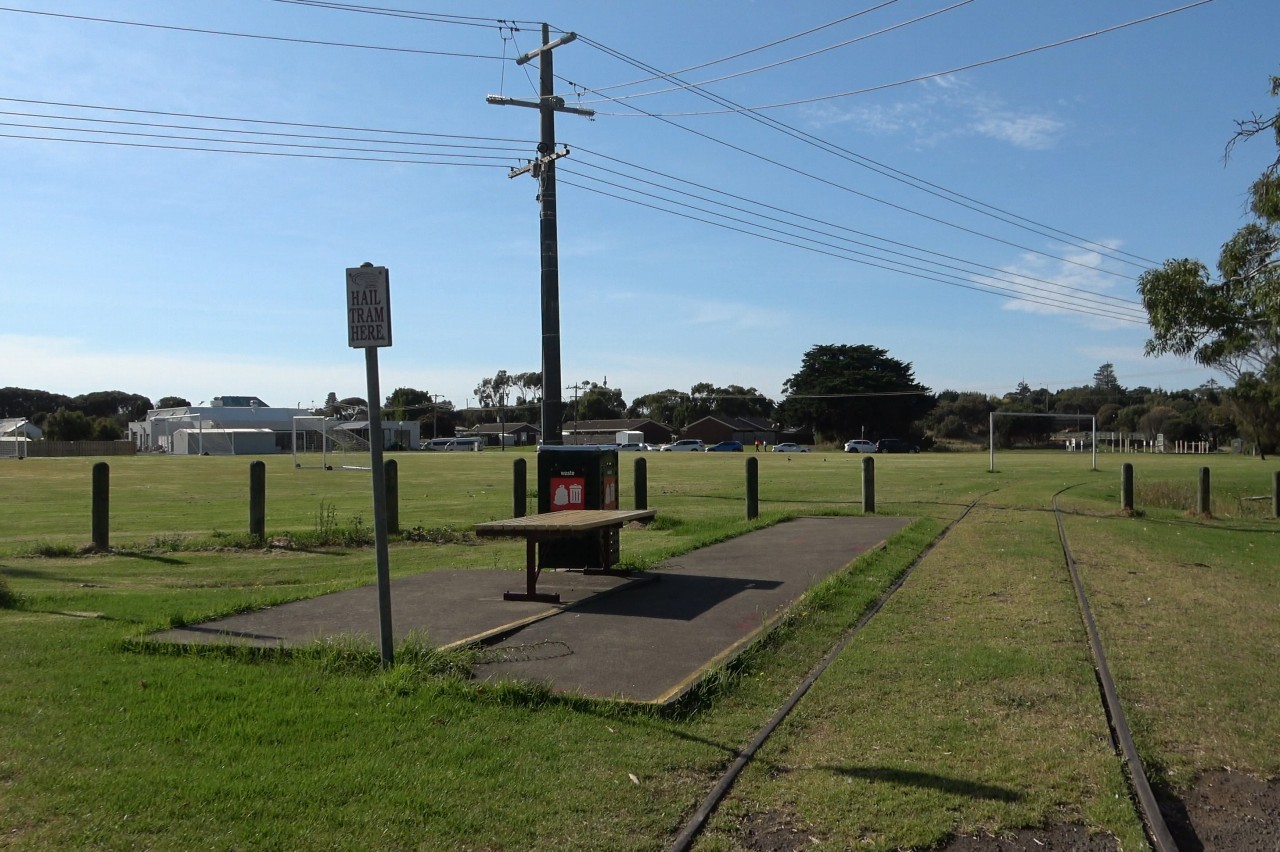
トラムデポ駅を発車し、最初の停車駅であるパワーハウスミュージアム駅。
この駅は当路線の起点であり、バルーンループ上にあります。
ポートランドケーブルトラムの駅で唯一駅舎が設置されていません。
Powerhouse Museum Station is the first stop after leaving Tram Depot Station.
This station is the starting point of the line and is on the Balloon Loop.
It is the only Portland Cable Tram station without a station house.
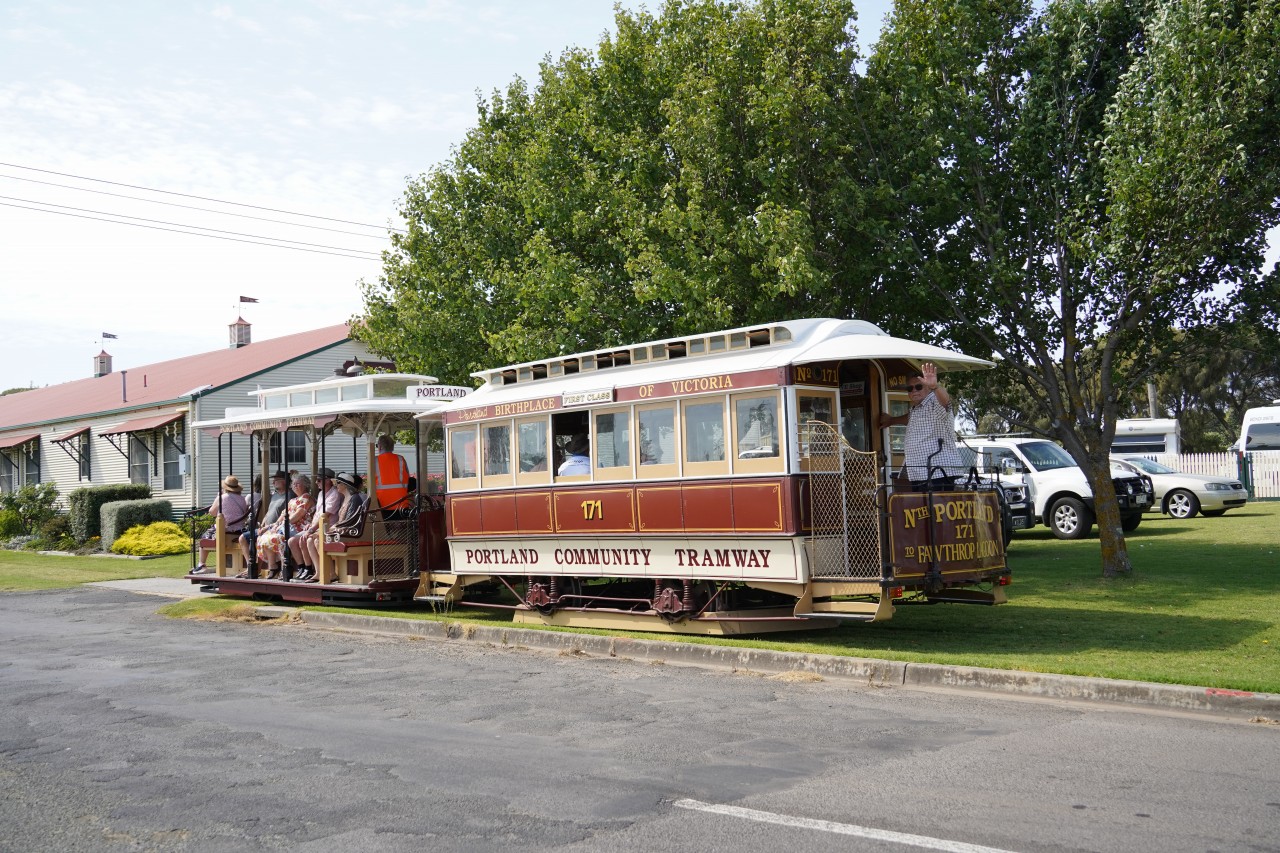
パワーハウスミュージアム駅を発車したトラムは先ほどの踏切を通過し、再びトラムデポ駅に戻ってきました。
トラムデポ駅の始発時間に乗り遅れても、パワーハウスミュージアム駅から帰ってきたトラムを捕まえることも可能です。
Trams departing from Powerhouse Museum Station pass through the level crossing mentioned earlier and return to Tram Depot Station.
If you miss the first tram at Tram Depot Station, you can still catch a tram returning from Powerhouse Museum Station.
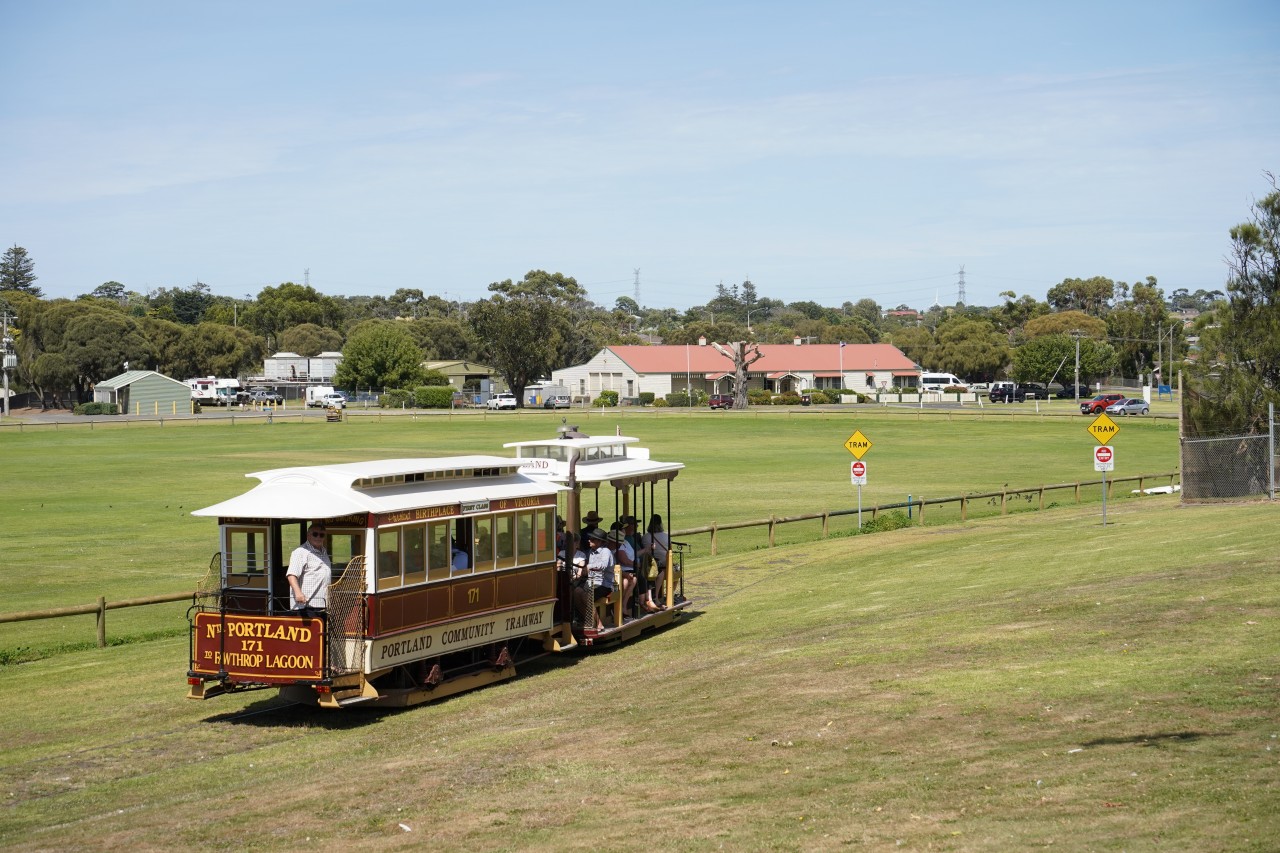
トラムデポ駅を通過後、隣接する運動場の外周を半周します。
奥に見えている赤い三角屋根の建物がトラムデポ駅です。
After passing through the tram depot station, the tramway makes a half-circle around the perimeter of the adjacent sports ground.
The building with the red triangular roof at the back is the tram depot station.
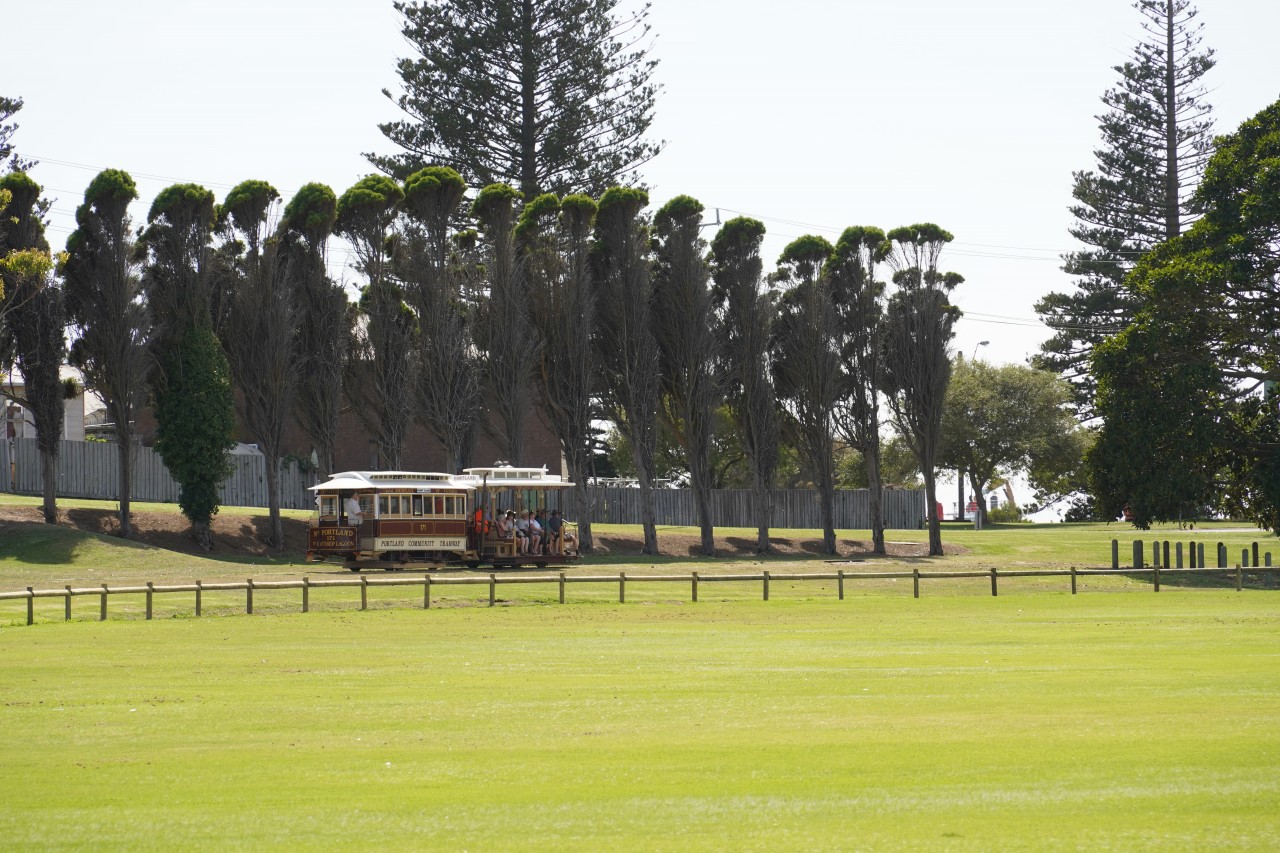
運動場の傍を通過するトラム。
この日は平日のため閑散としていましたが、休日になれば多くの人で賑わっていることでしょう。
Tram passing by the sports ground.
It was quiet on this day because it was a weekday, but on a holiday it would be busy with many people.
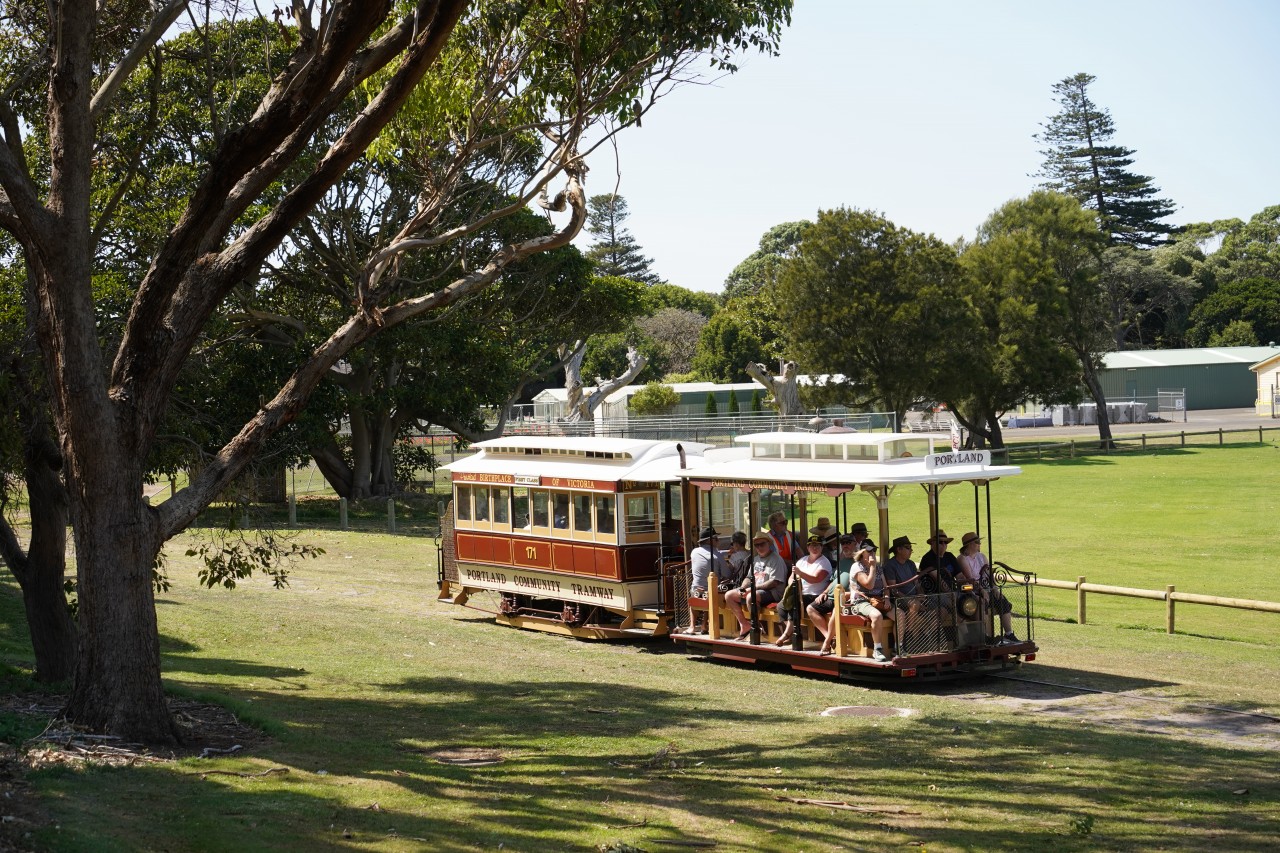
運動場を抜けると緩やかな坂を上り、ボタニックガーデン駅に近づきます。
The tram goes up a gentle slope past the sports ground and approaches the Botanic Gardens station.
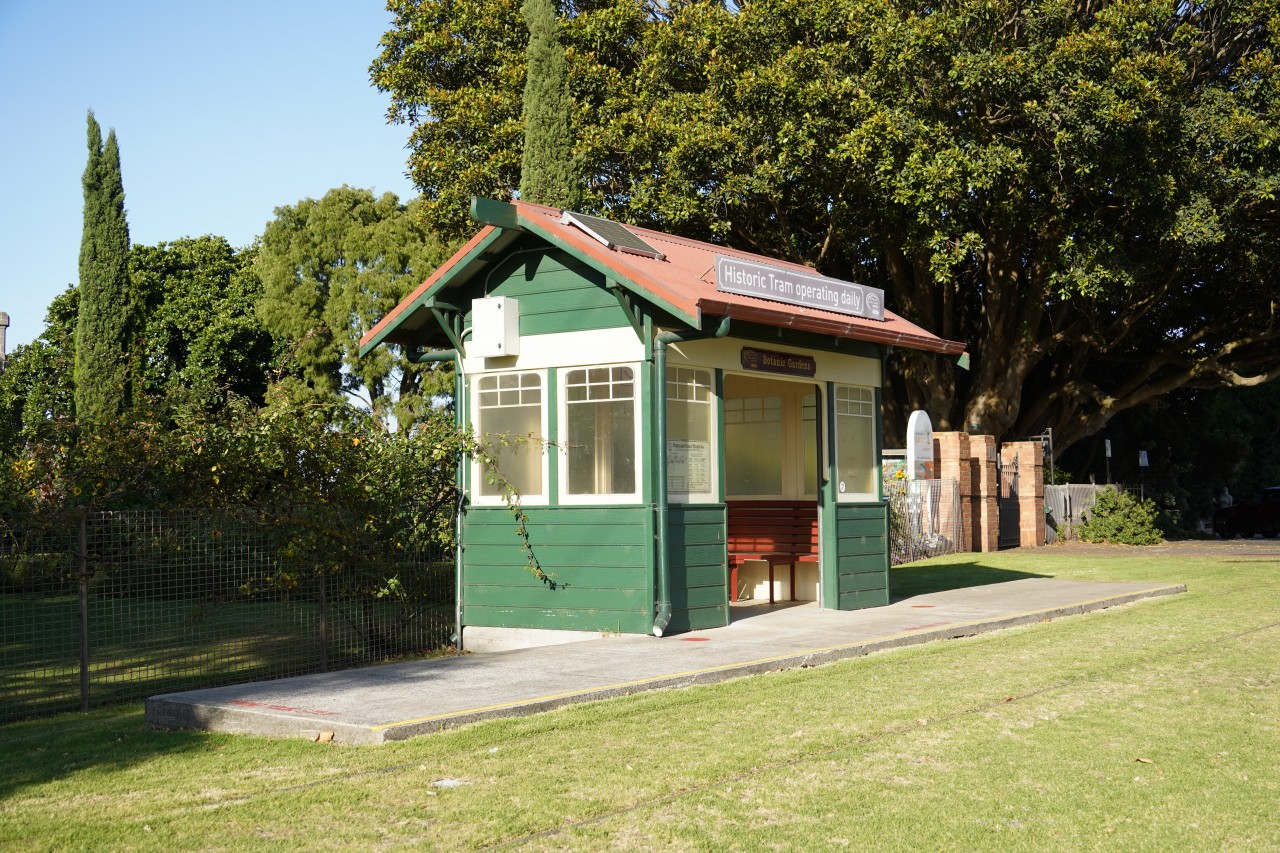
ボタニックガーデン駅は小さな駅舎がある可愛らしい駅です。
この先終点のタワールックアウト駅までの駅は殆ど同じ構造となります。
Botanic Garden station is a pretty station with a small station house.
From here on, most of the stations up to the final station, Tower Lookout, have the same structure.
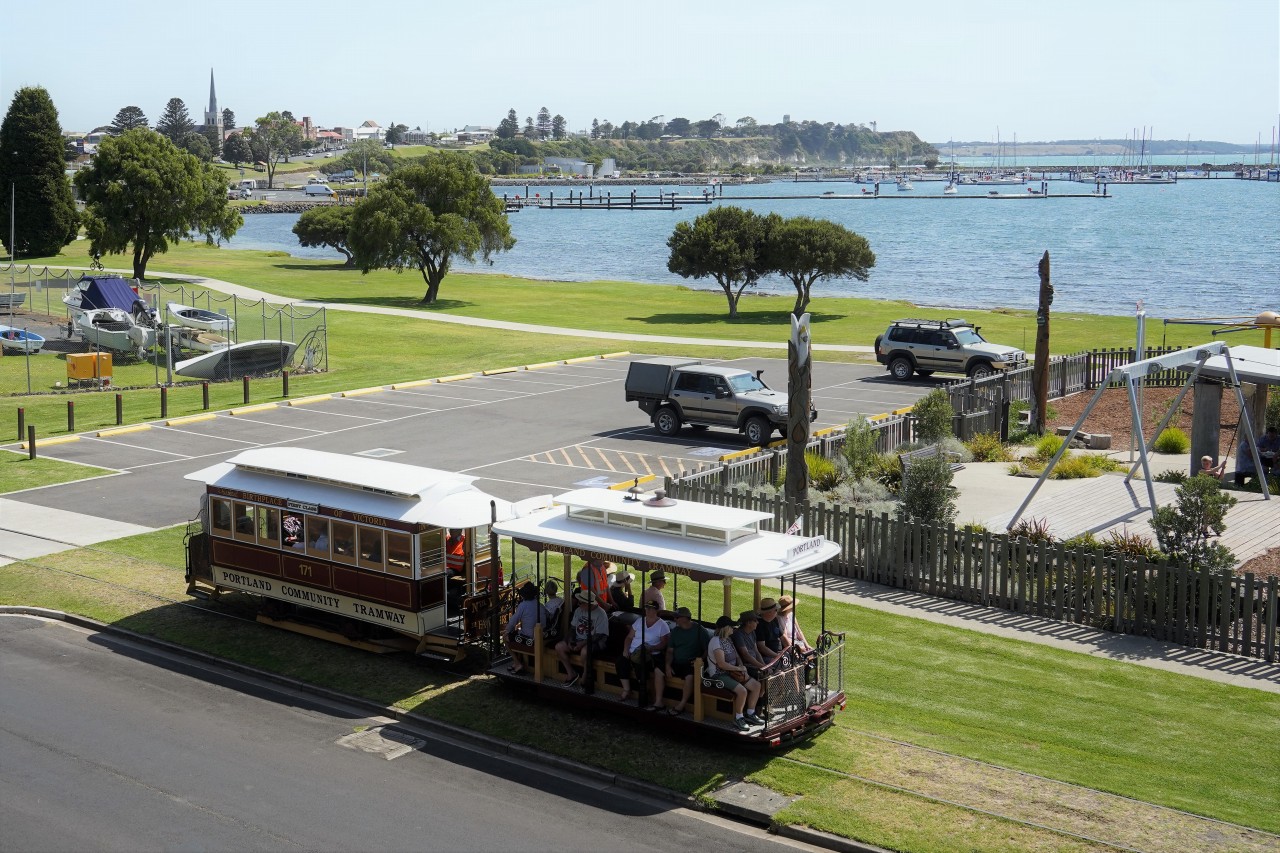
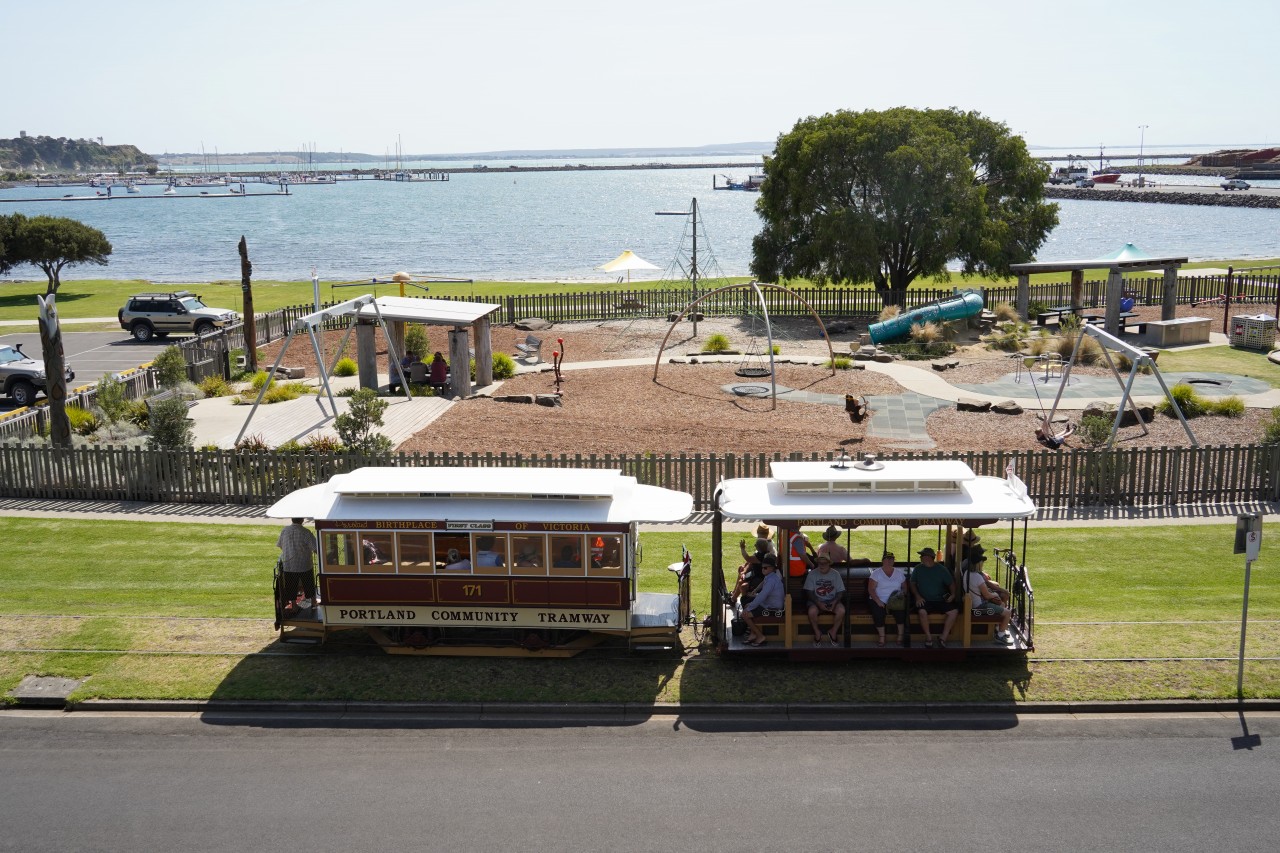
ボタニックガーデン駅を過ぎると、トラムは終点のタワールックアウト駅まで海岸沿いを走ります。
After passing Botanic Garden Station, the tram runs along the coast to its terminus at Tower Lookout Station.
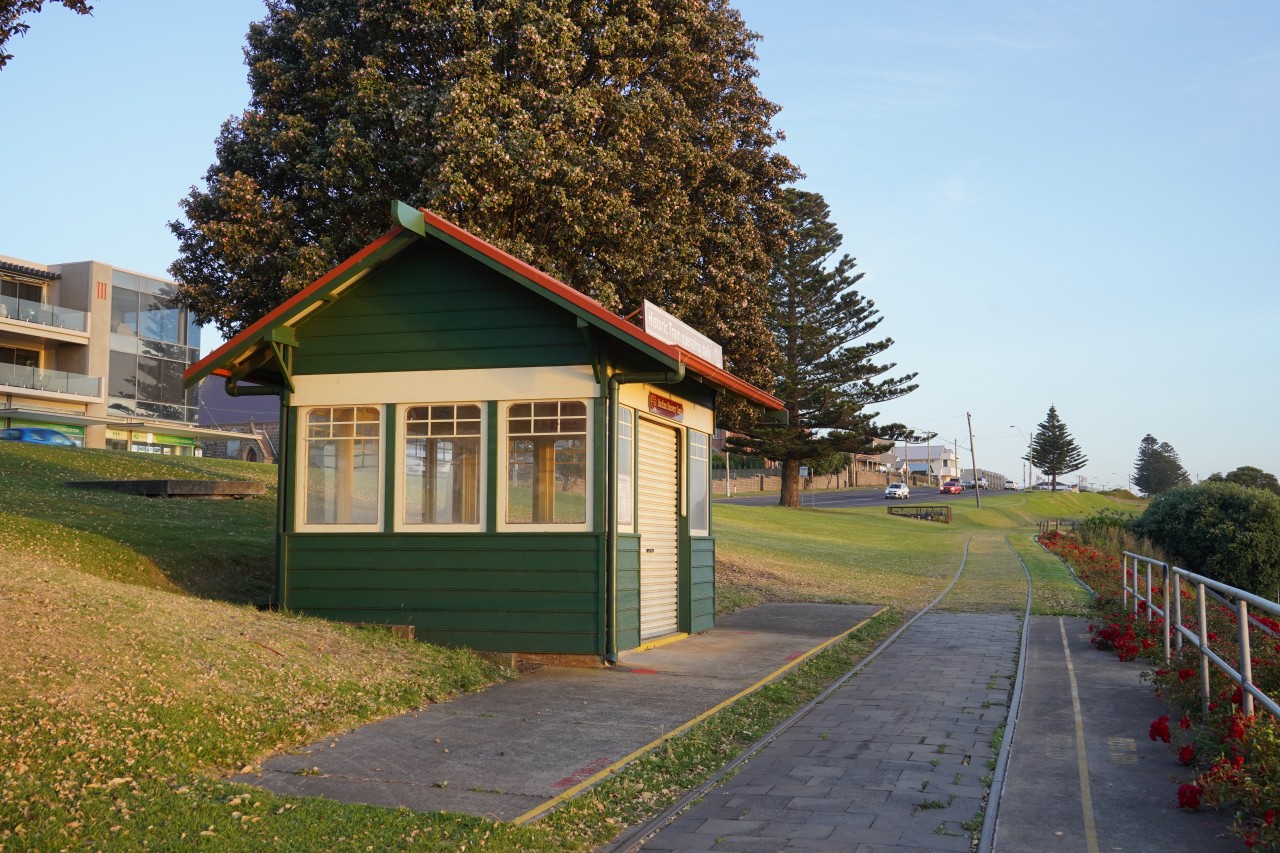
マリタイムディスカバリーセンター駅。ビジターセンターが近くにあり、観光の拠点となっています。
早朝にこの駅を撮影したため、駅舎はまだシャッターが閉まっています。
Maritime Discovery Center station. A visitor centre is located nearby and serves as a tourist hub.
As this station was photographed early in the morning, the station house is still shuttered.
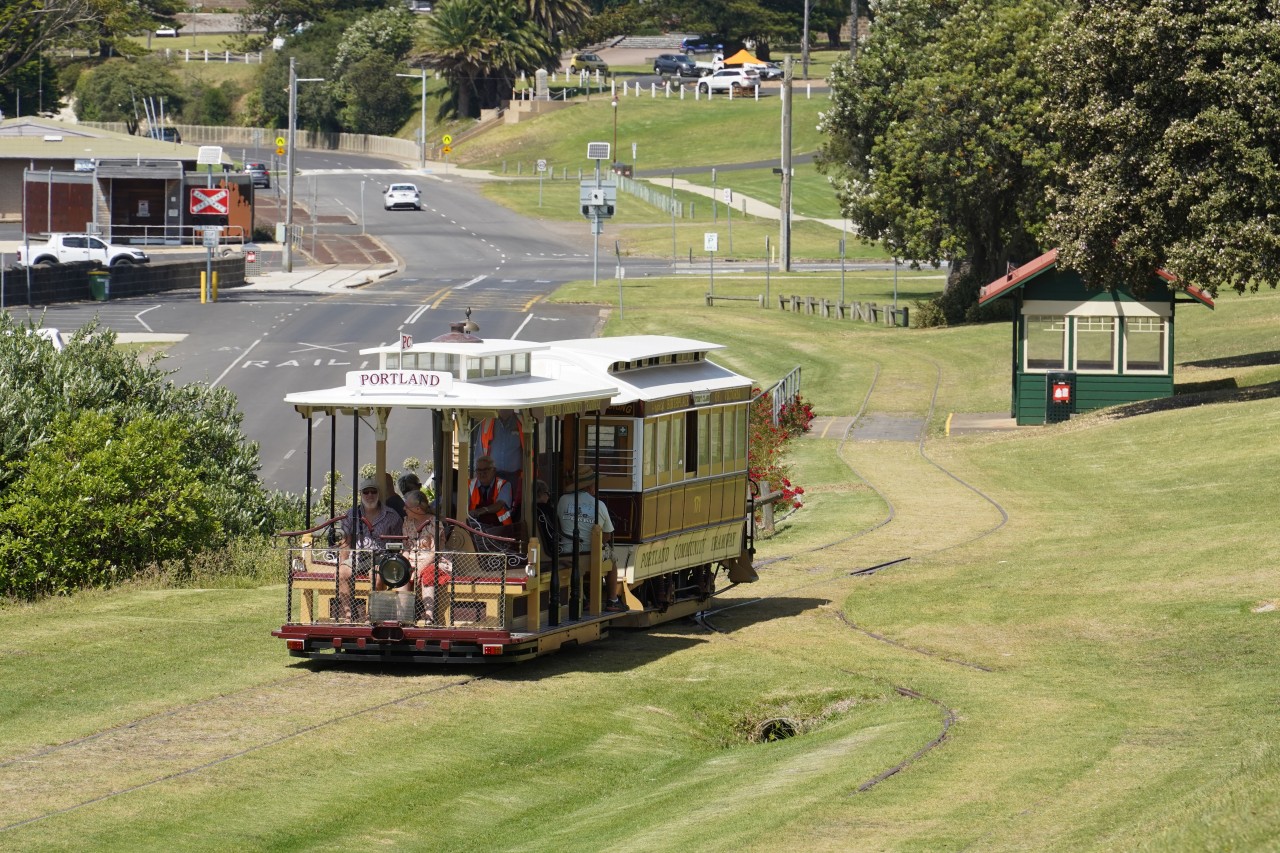
マリタイムディスカバリーセンター駅を発車したトラム。
路線の中間に近いこの場所には通過側線が設けられ、トラムどうしがすれ違いできるようになっています。
ポイントは恐らく手動で、通常は直進する線のみが使用されています。
ポートランドケーブルトラムはグリップカーとサルーンカーがそれぞれ2台あるため、この通過側線を使用すれば最大で毎時2本の運行が可能です。
Tram departing from Maritime Discovery Center station.
A passing sidings line is provided here, close to the middle of the line, to allow trams to pass each other.
The points are probably manual and usually only the straight-through line is used.
As the Portland Cable Tram has two grip cars and two saloon cars each, this passing sidings line can be used for up to two services per hour.
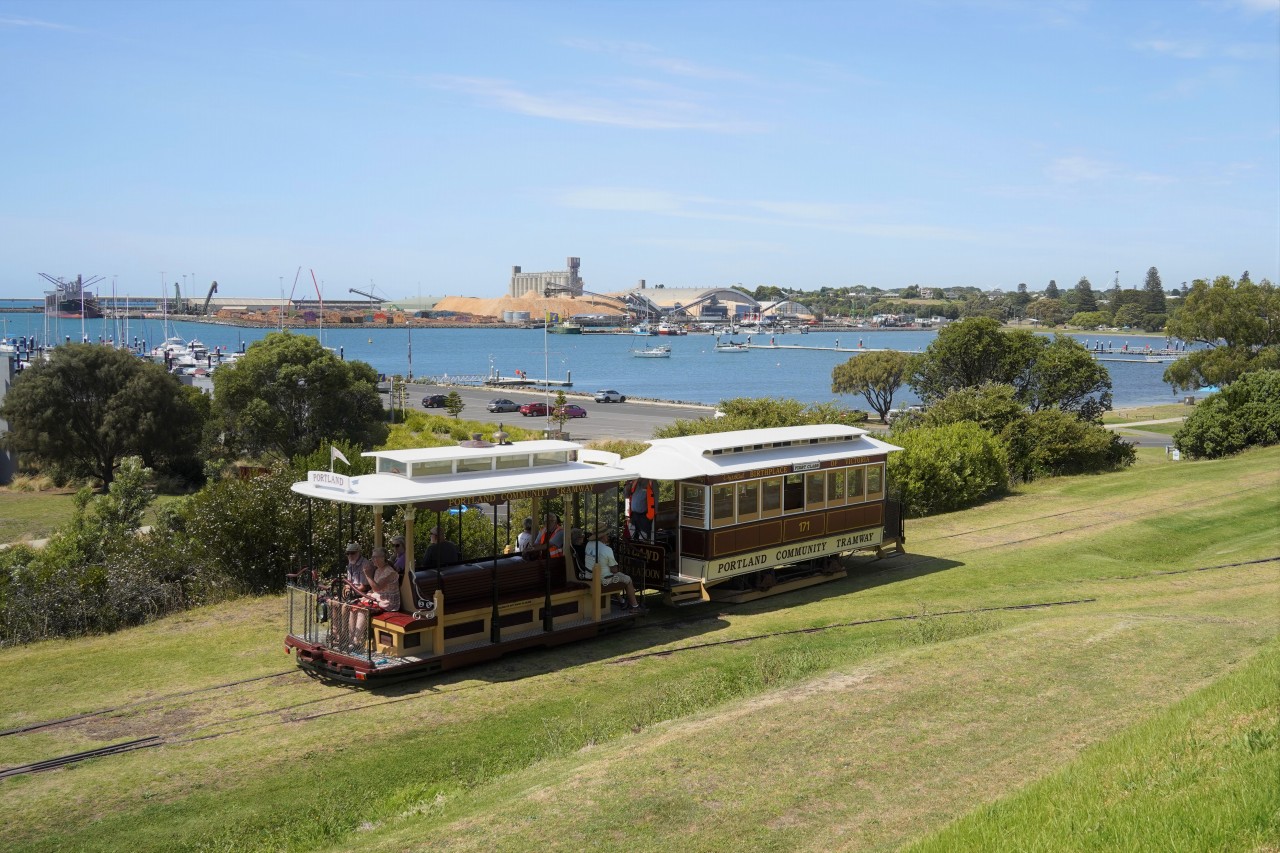
通過側線の本線上を通過するトラム。
坂を上るため、この付近が一番海を見渡せるスポットになります。
お土産の絵葉書もこの場所で撮影されたものがありました。
この場所にて順光でトラムを撮影できるのは最終便です。
(画像は2月中頃の最終1本前の第4便)
Trams pass over the main line of the passing sidings.
As it goes up the hill, this area offers the best view of the sea.
Some souvenir postcards were also taken here.
The last tram is the best place to take beautiful photos in good light.
(The image shows the fourth tram before the last one in mid-February.)
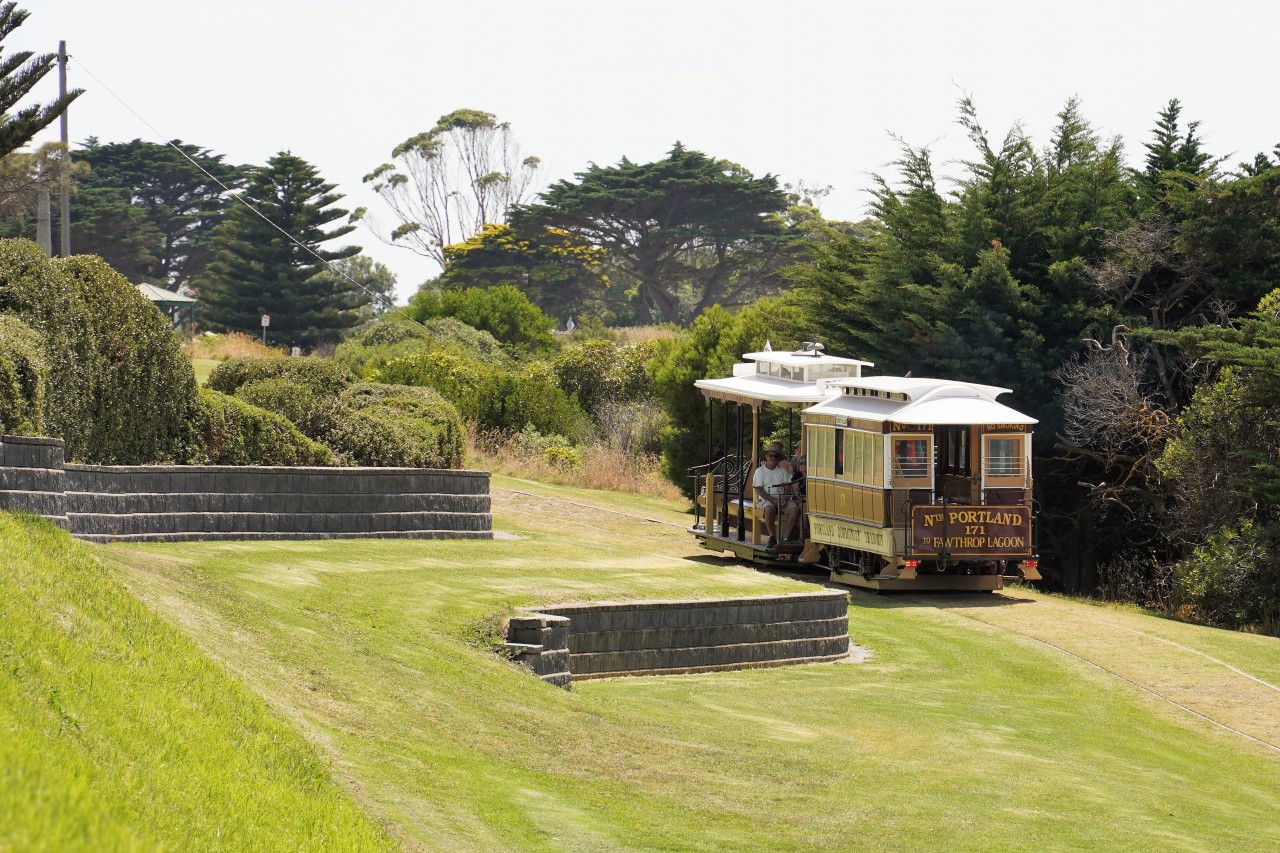
かなり勾配のある坂を登ります。
ディーゼルエンジンが一番唸りを上げるポイントになります。
It climbs up a very steep hill.
This is the point where the diesel engine roars the most.
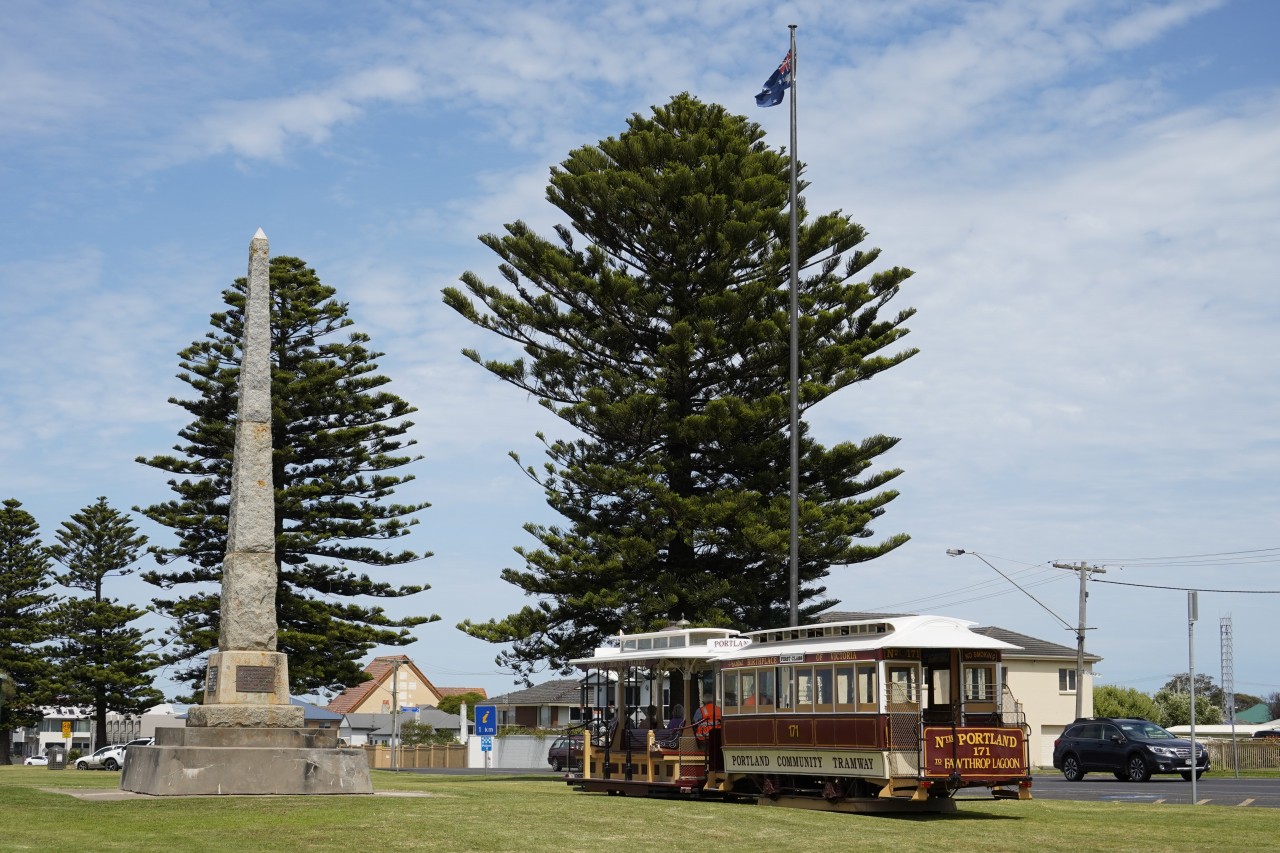
坂を登りきるとベイホリデーパークの中を通過します。
先ほどよりも高い位置から海を望むことができる綺麗なベイホリデーパークです。
The tram passes through the Bay Holiday Park as it climbs the hill.
This is a beautiful park with a higher view of the sea than before.
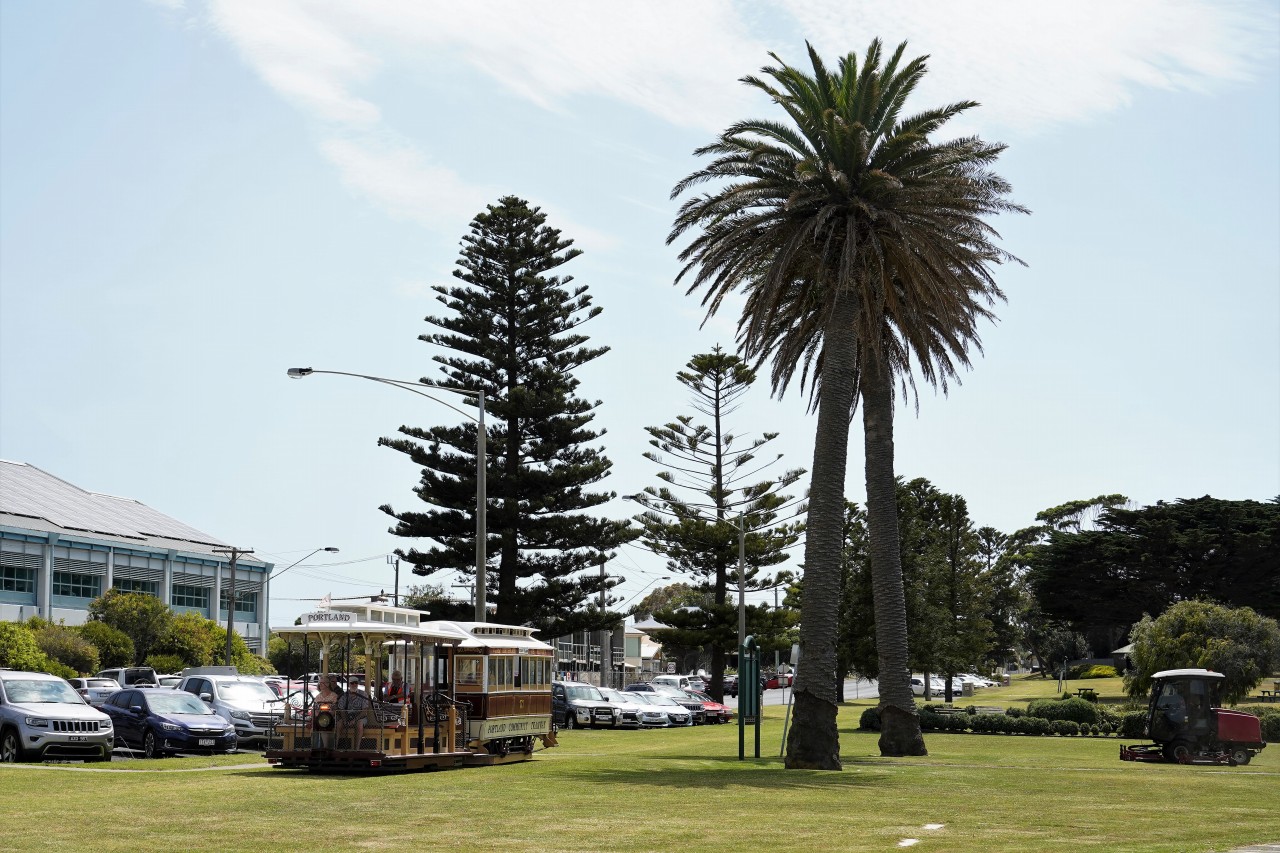
芝刈り自動車によって綺麗に整備されたベイホリデーパークを通過するトラム。
このベイホリデーパークは公衆トイレも整備されており、のんびりとピクニックを楽しむことができます。
The tram passes through a Bay Holiday Park that is neatly maintained by lawnmowing vehicles.
Bay Holiday Park is also equipped with public toilets and offers a relaxing picnic.
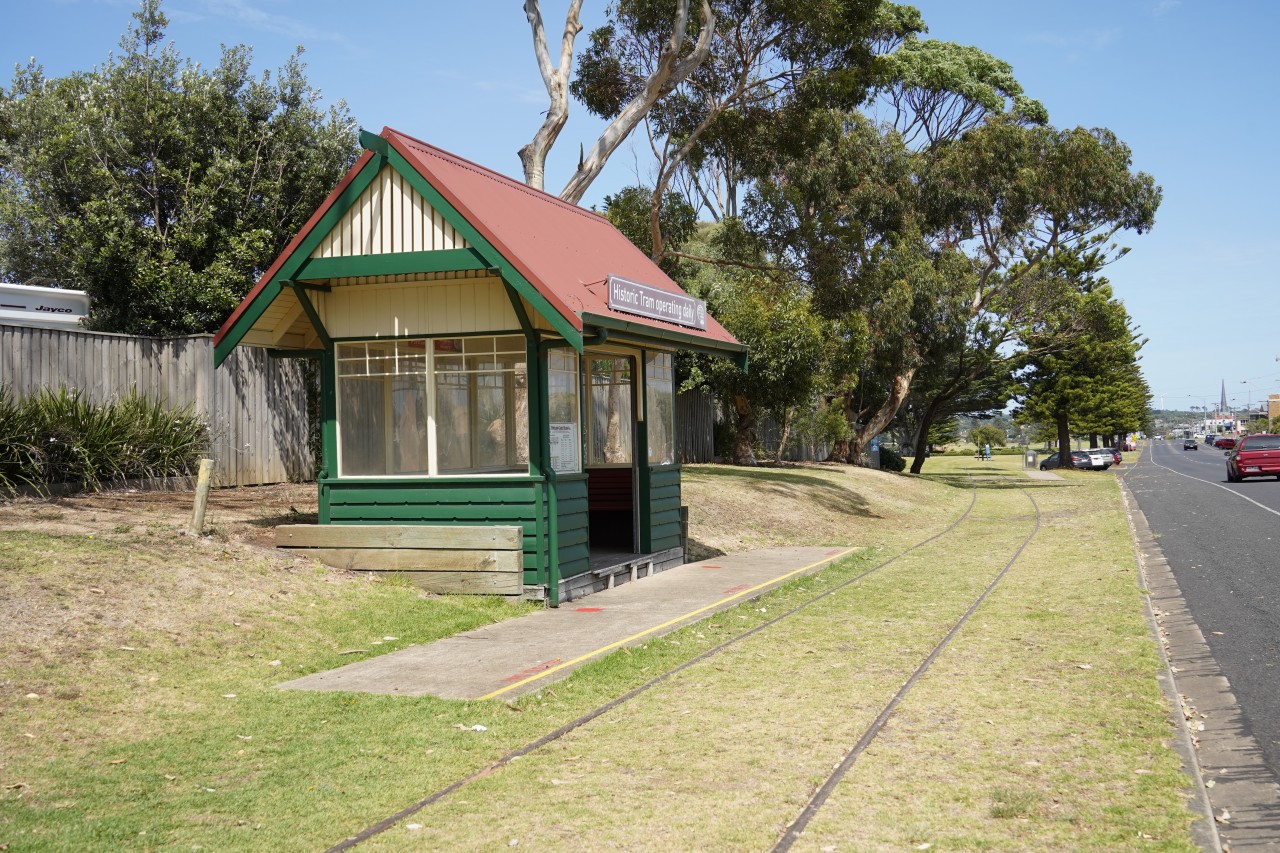
ベイホリデーパーク駅は公園を抜けた先に位置します。
次は終点タワールックアウト駅です。
Bay Holiday Park station is located at the end of the park.
Tower Lookout Station is the next to the end of the line.
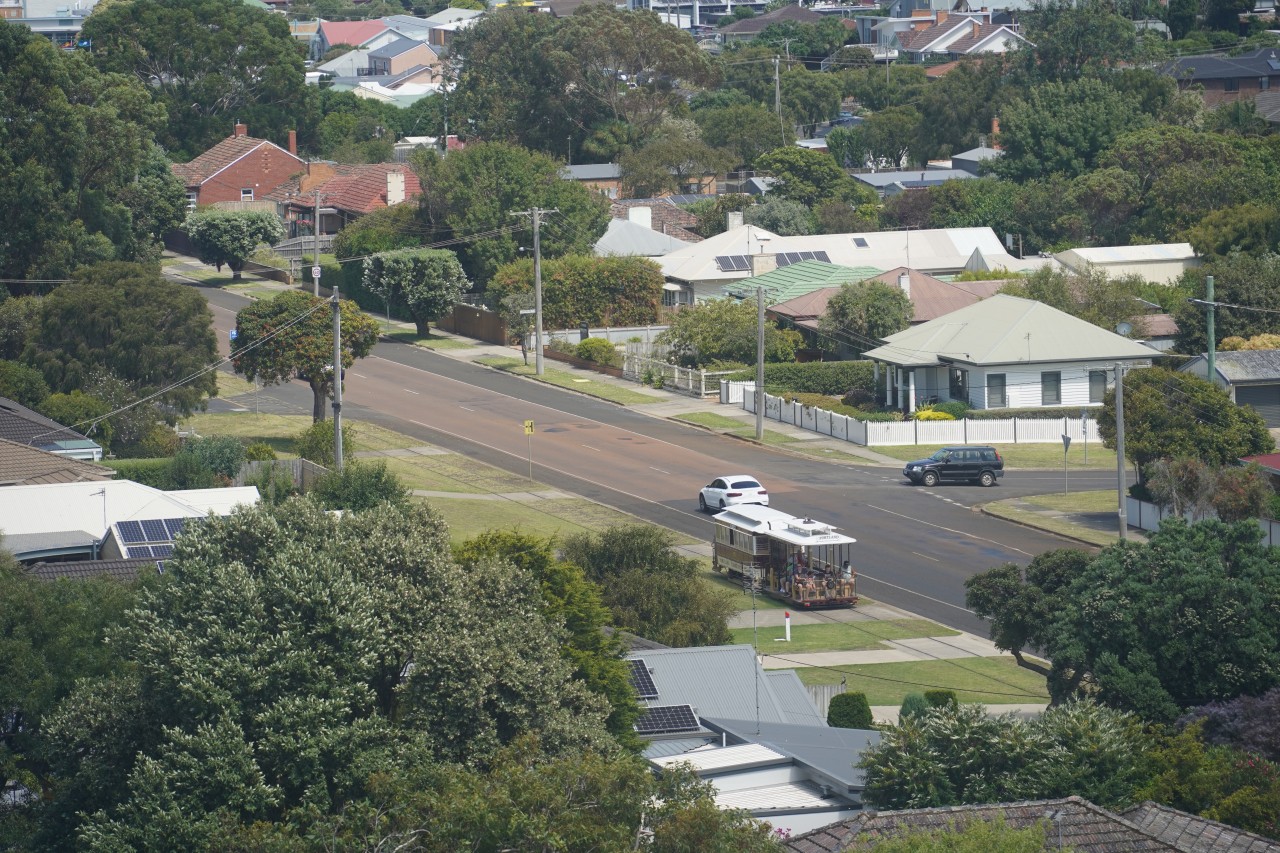
ベイホリデーパーク駅を発車し、終点のタワールックアウト駅を目指すトラムを終点のタワー展望台より撮影。
Tram leaving Bay Holiday Park station for Tower Lookout station, photographed from the tower lookout at the end of the line.
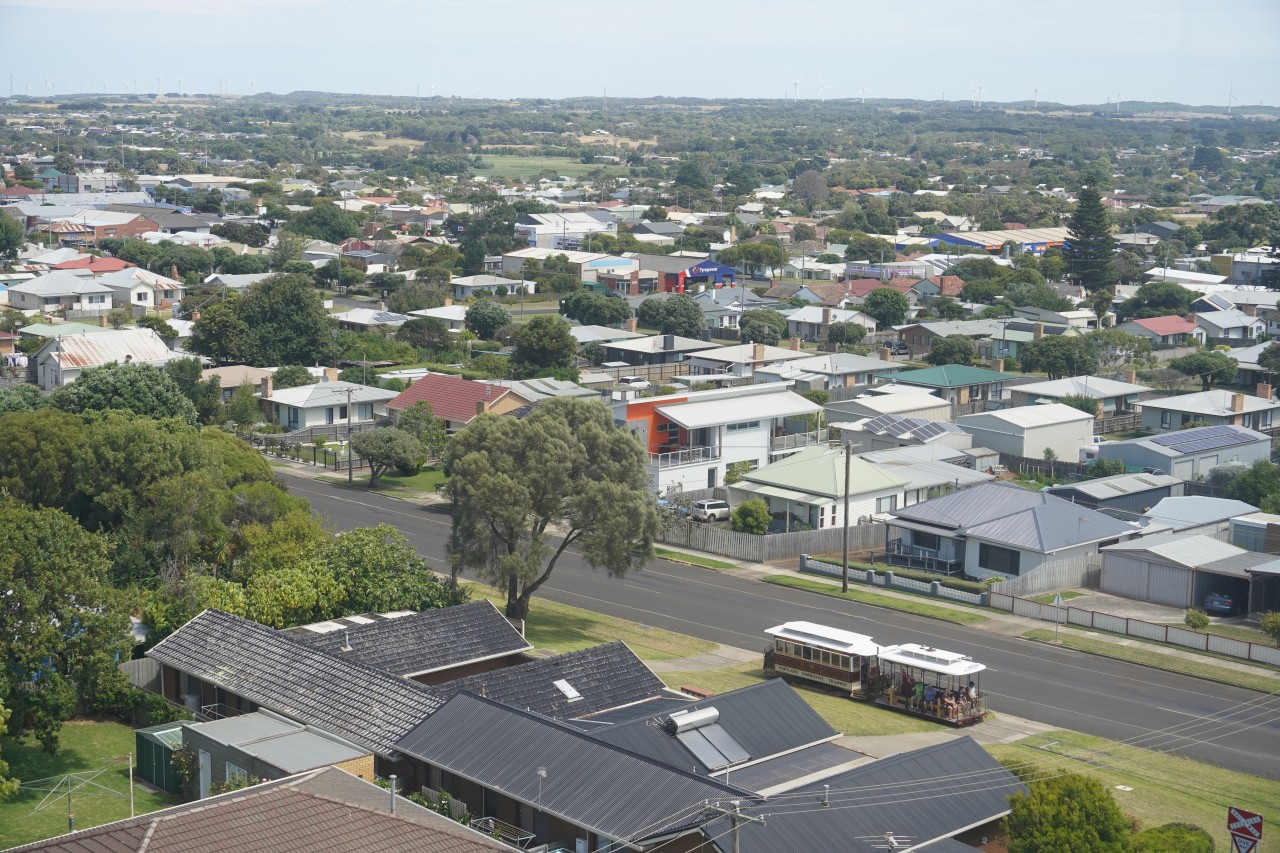
自然豊かなポートランドを走るトラム。
高い建物が殆どなく、WW2博物館となっているこのタワーがポートランドで一番高い建物だと思われます。
Trams run through the natural beauty of Portland.
There are few tall buildings, and this tower, which serves as the WW2 museum, is probably the tallest building in Portland.
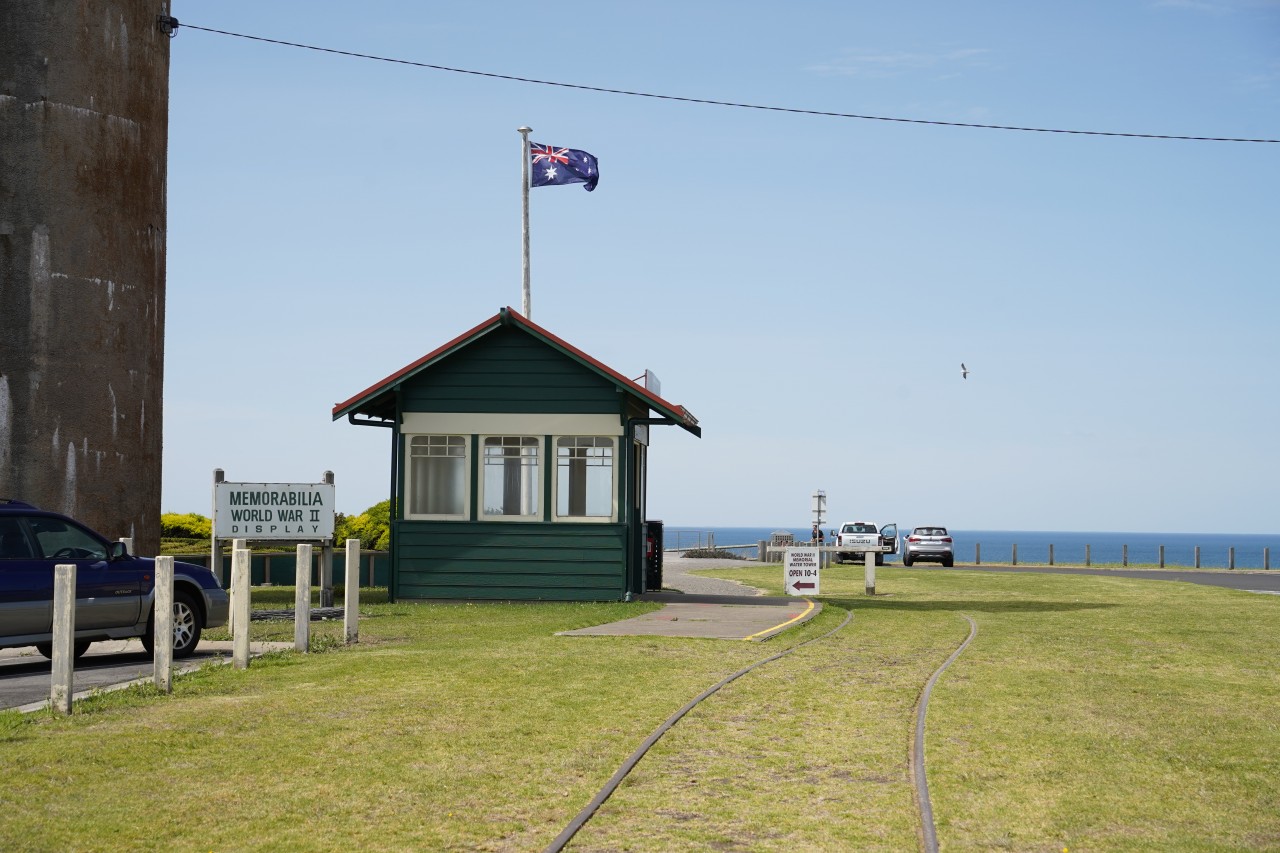
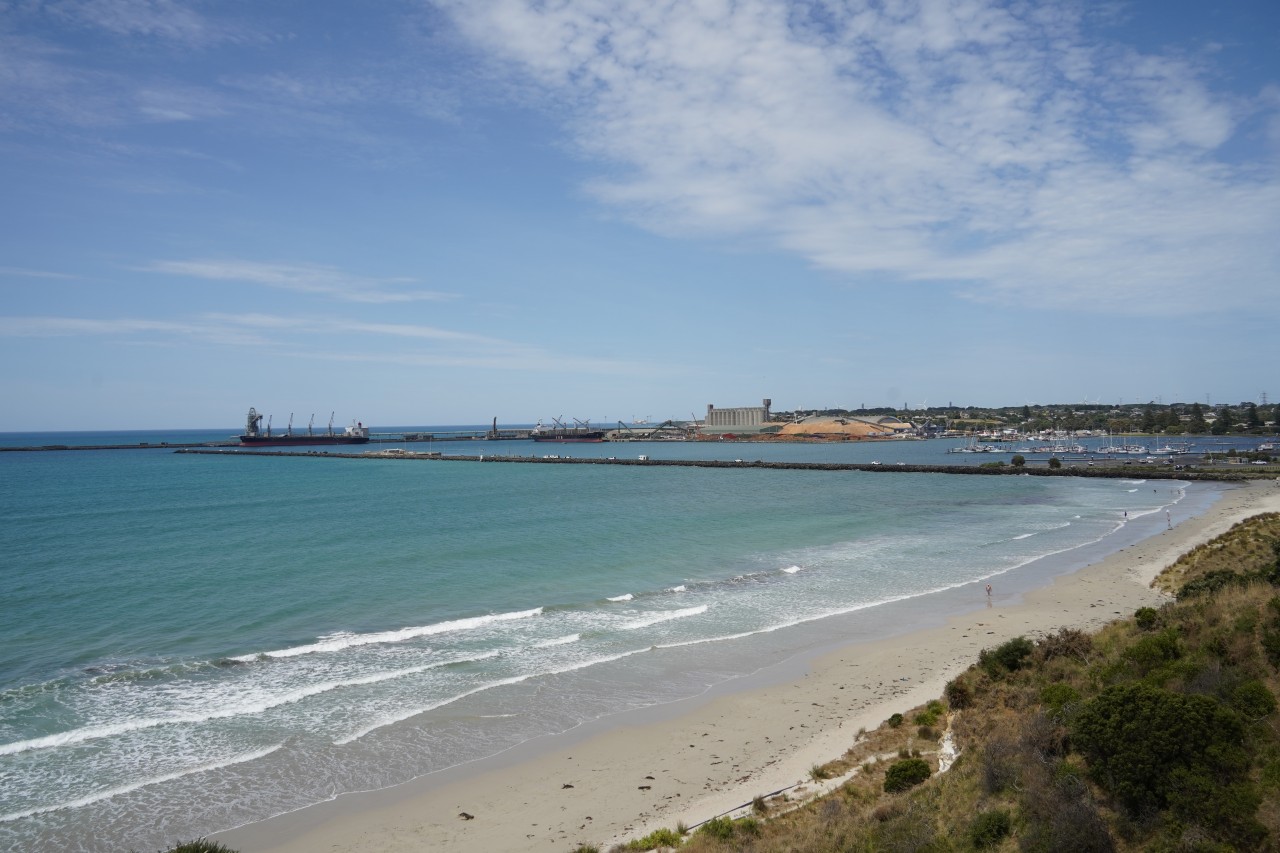
終点のタワールックアウト駅。
こちらはループ線になっておらず、行き止まりとなっています。
トラムを降りると素晴らしい景色を望むことができます。
Tower Lookout station at the end of the line.
This is not a loop line and is a dead end.
There are great views as you get off the tram.
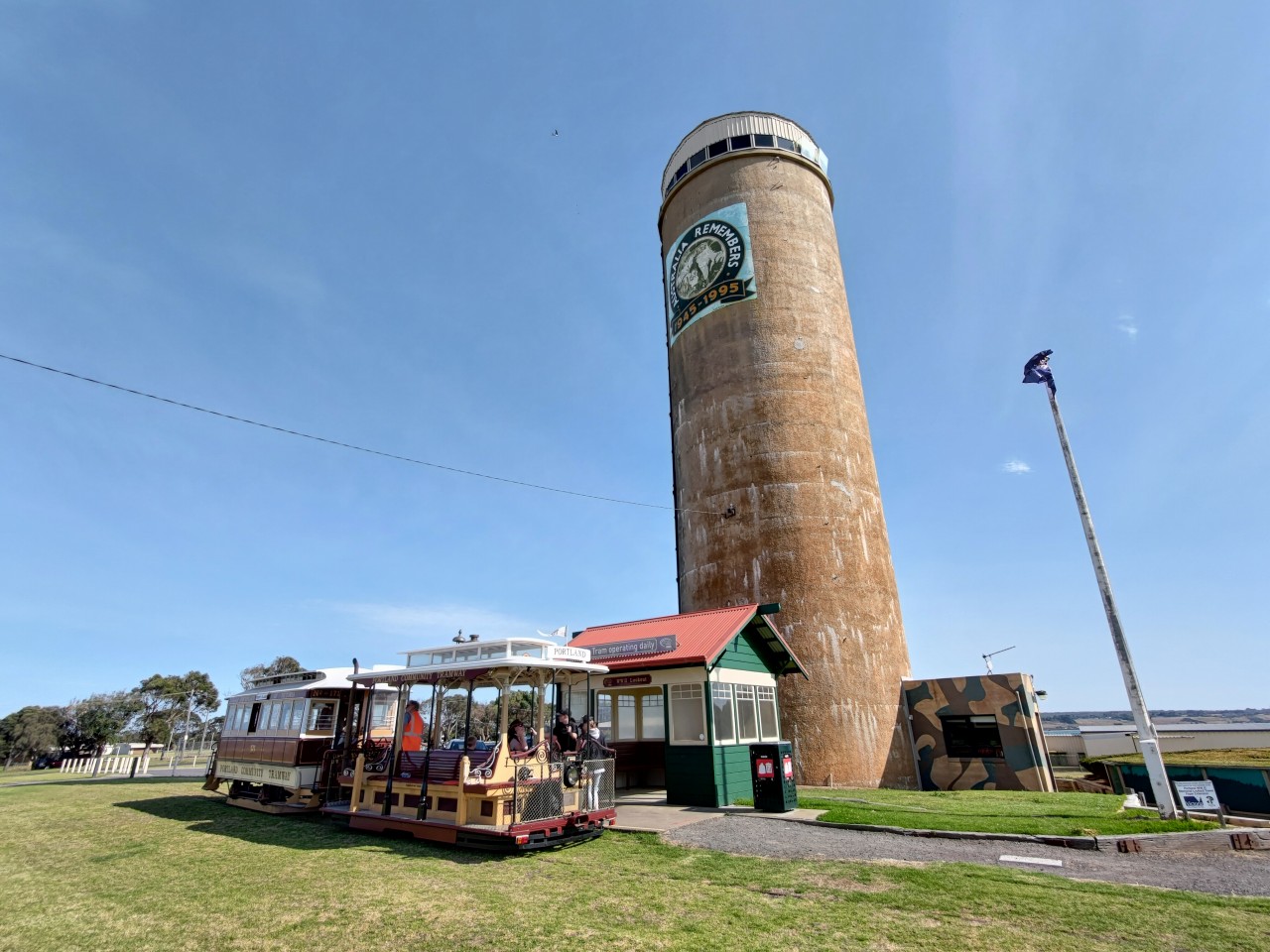
タワールックアウト駅のすぐ隣には、かつて給水塔だった建物を転用した第二次世界大戦博物館があります。
2023年2月時点では入場券の支払いは現金のみとなっています。
メルボルンやシドニーでは全ての支払いがキャッシュレス対応だったため、この時はオーストラリアを訪問して始めての現金払いを体験しました。
Immediately adjacent to Tower Lookout Station is the World War II Museum, which is housed in a building that was once a water tower.
As of February 2023, admission tickets are cash only.
This was the first time I paid cash on a visit to Australia, as all payments were cashless in Melbourne and Sydney.
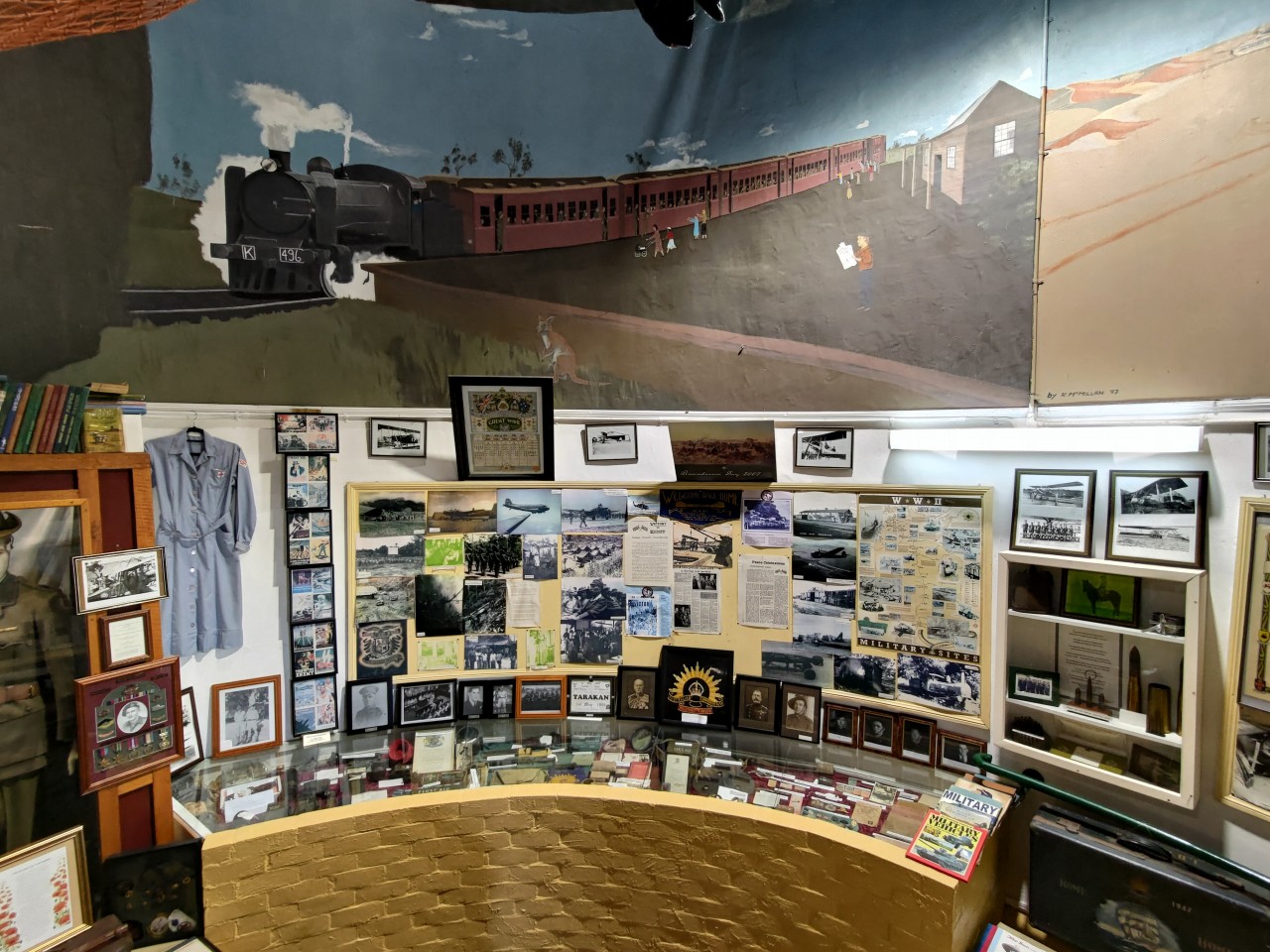
博物館の中には第二次世界大戦に関連するものが展示されています。
また、壁にはKクラス蒸気機関車が描かれています。
Kクラスは1922年から1979 年までオーストラリアのビクトリア鉄道で運行された支線蒸気機関車です。
その設計は完全に従来のもので、仕様は目立ったものではありませんでしたが、実際には、Kクラスは非常に多用途で信頼できる機関車でした。
この蒸気機関車は、VR で定期運行されている他のすべてのクラスの蒸気機関車よりも長持ちし、当初製造された 53 両のうち 21 両以上が保存されています。
車両ナンバーは100-109(後に140-149)、150-192のため、描かれている496は存在しないナンバーです。
Inside the museum, items relating to the Second World War are on display.
Also on the walls is a K-class steam locomotive.
The K-class was a branch line steam locomotive that operated on the Victoria Railway in Australia from 1922 to 1979.
Although its design was entirely conventional and its specifications were unremarkable, the K-class was in fact a very versatile and reliable locomotive.
They outlasted all other classes of steam locomotives in regular service on the VR, and more than 21 of the 53 originally built have been preserved.
Vehicle numbers 100-109 (later 140-149) and 150-192, so the 496 depicted are non-existent numbers.
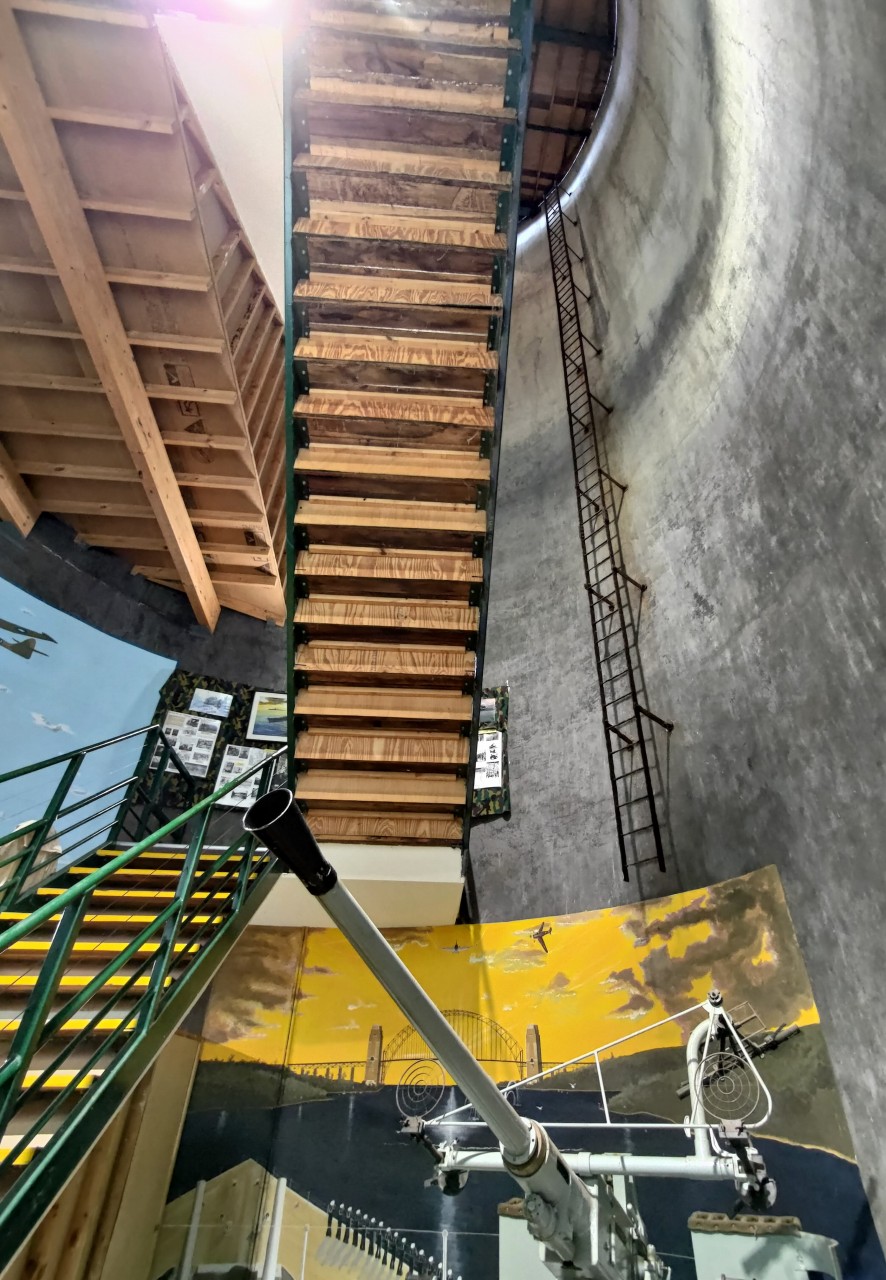
建物内はもともと給水タンクであった空洞に階段とフロアが設置されています。
壁に設置されている梯子は給水塔として使用していた時代から残っているものを思われます。
Inside the building, the staircase and floor are set in a cavity that was originally a water tank.
The ladders on the walls appear to have survived from the period when the building was used as a water tower.
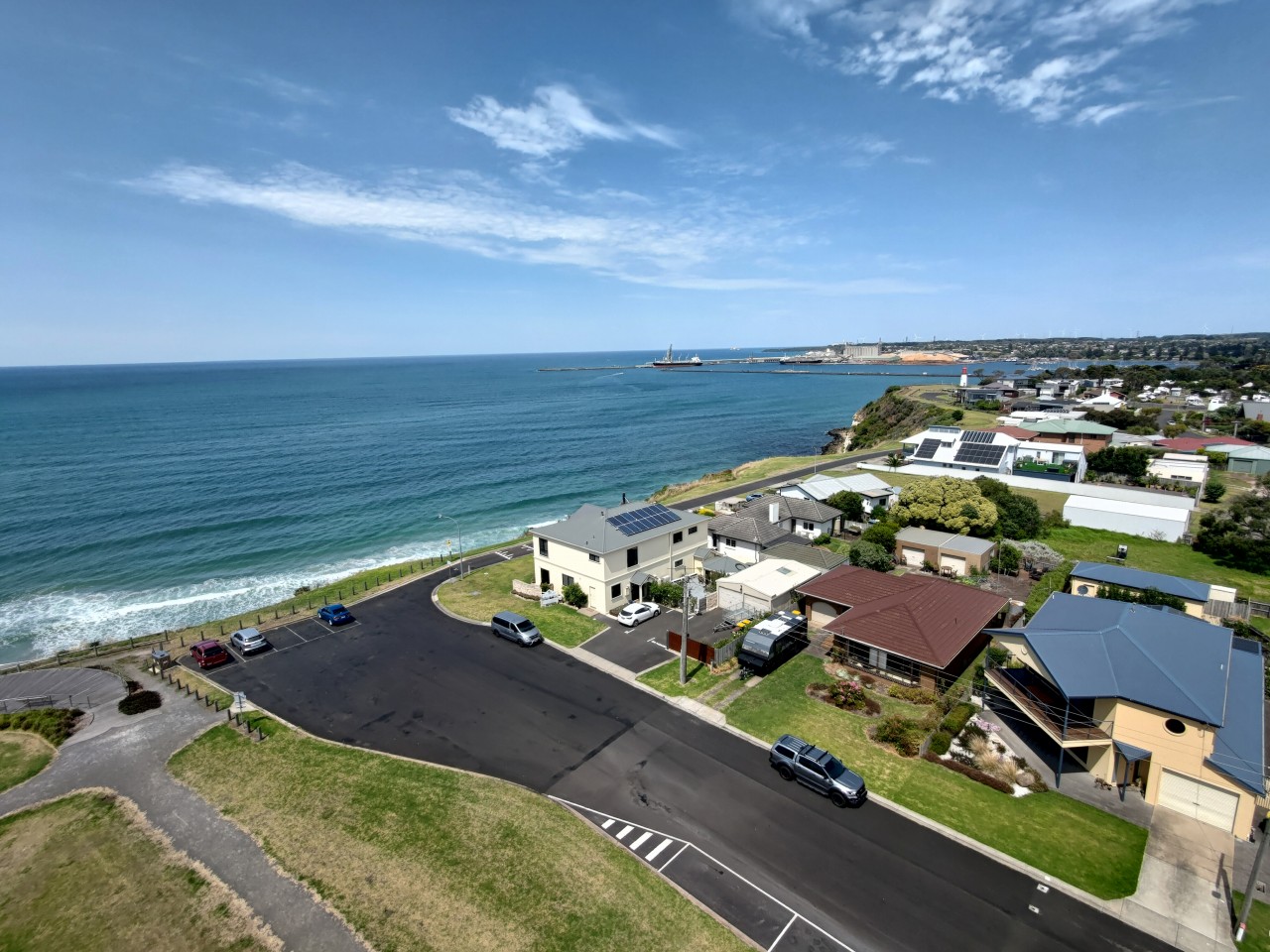
展望フロアからは美しい海岸線を見下ろすことができます。
右端の海岸線の向こうには始発のトラムデポ駅があります。
このフロアはエアコンが無いため夏場は非常に暑く、トラムを撮影するために長時間滞在する場合は熱中症に気を付ける必要があります。
The observation floor overlooks the beautiful coastline.
Beyond the coastline on the far right is the first tram depot station.
This floor is very hot in summer as there is no air-conditioning and you need to watch out for heat stroke if you stay for long periods to photograph the trams.
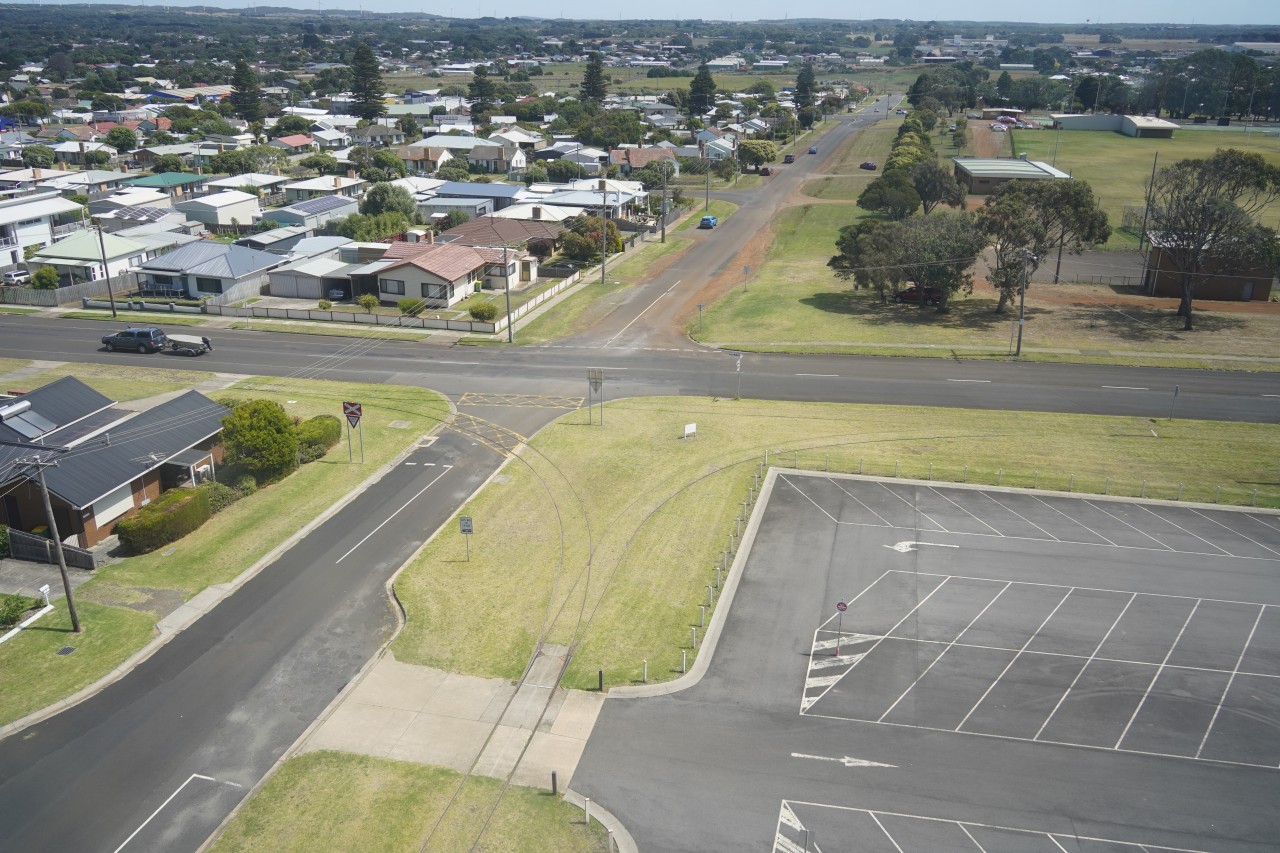
タワーからはトラムが折り返すために使用するシャンティングトライアングルエンド線を見ることができます。
From the tower you can see the chanting triangle end line used by the trams to turn around.
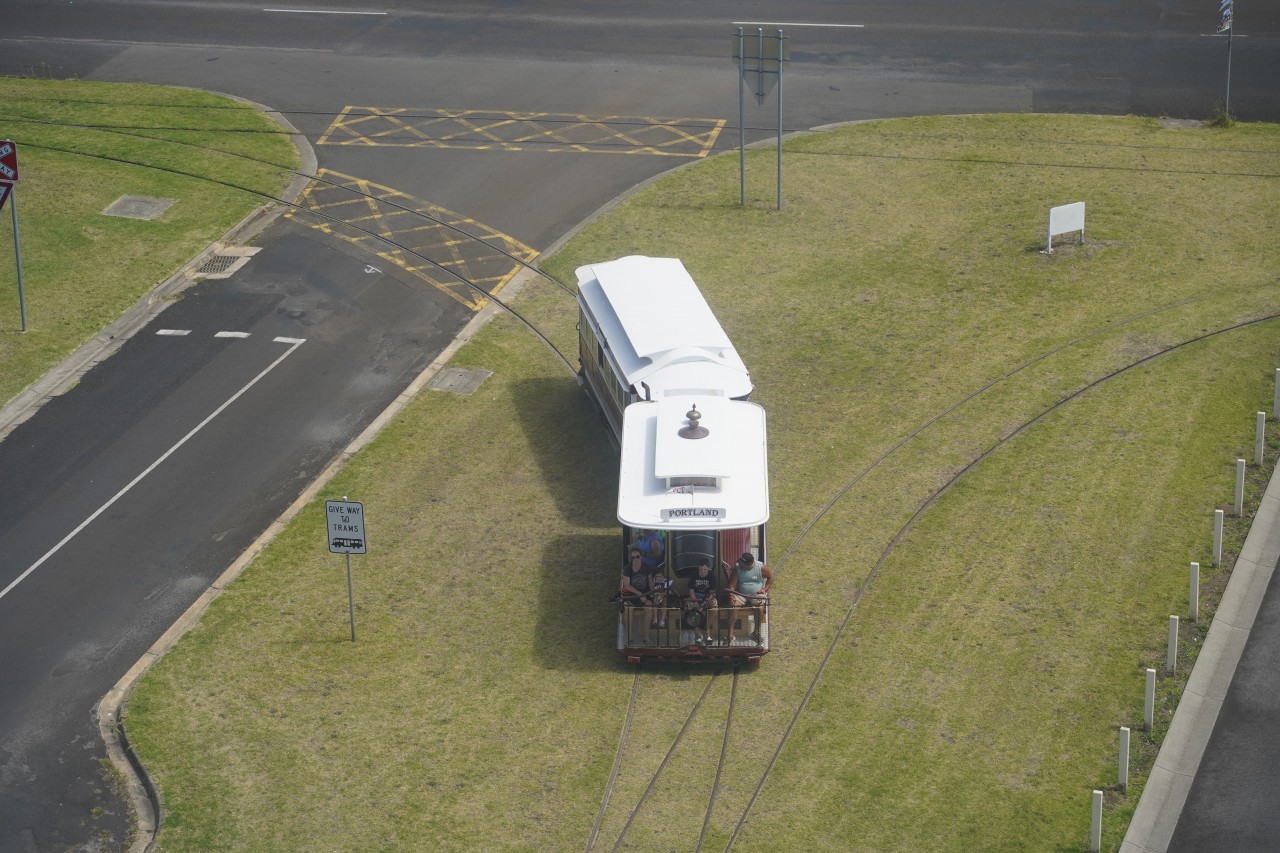
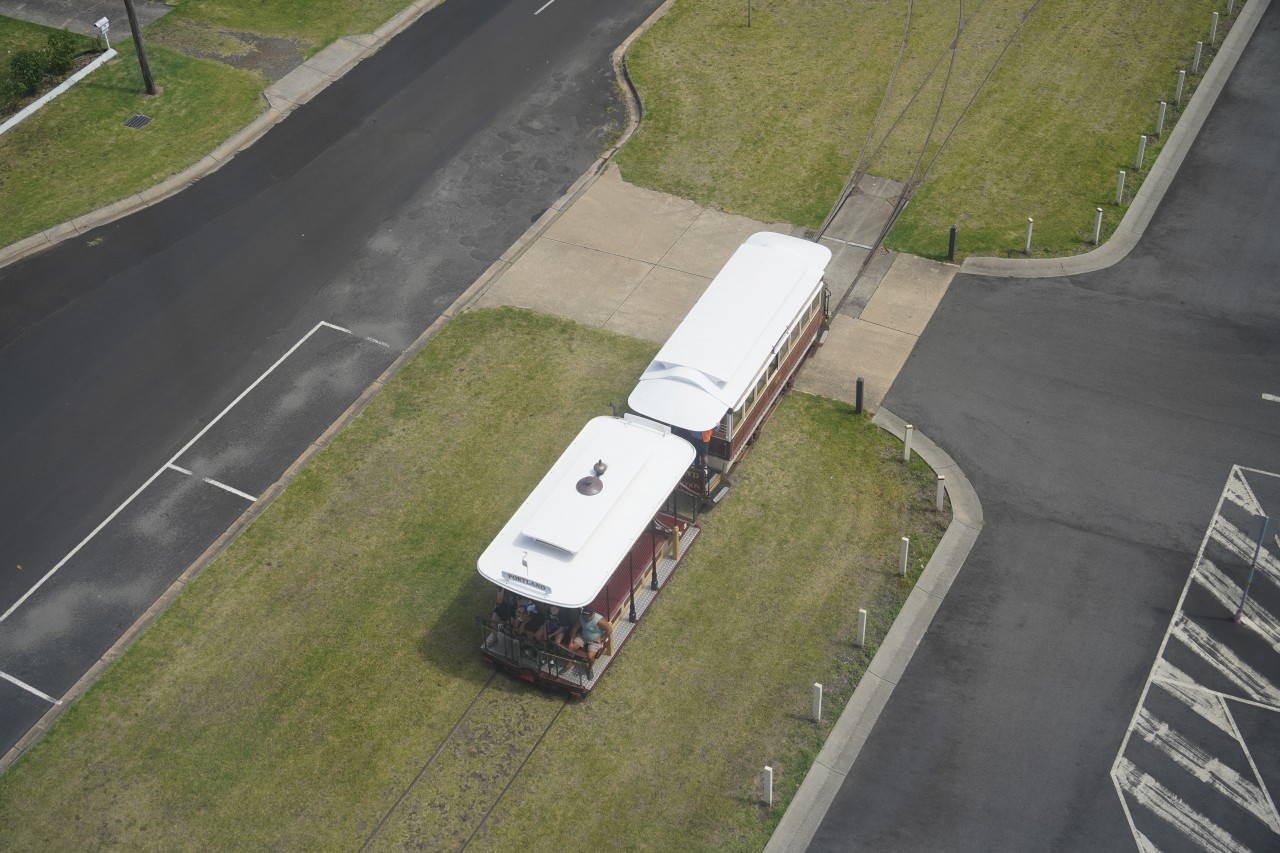
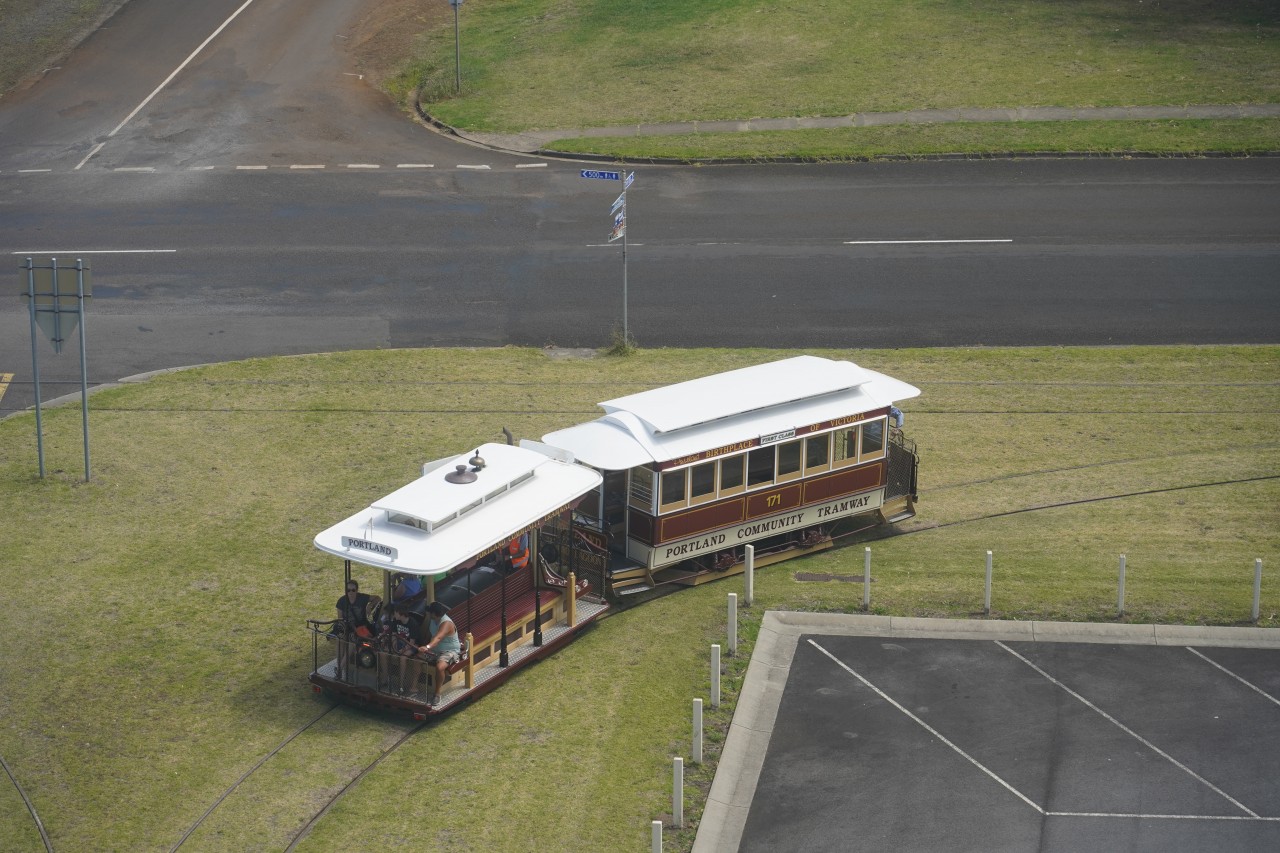
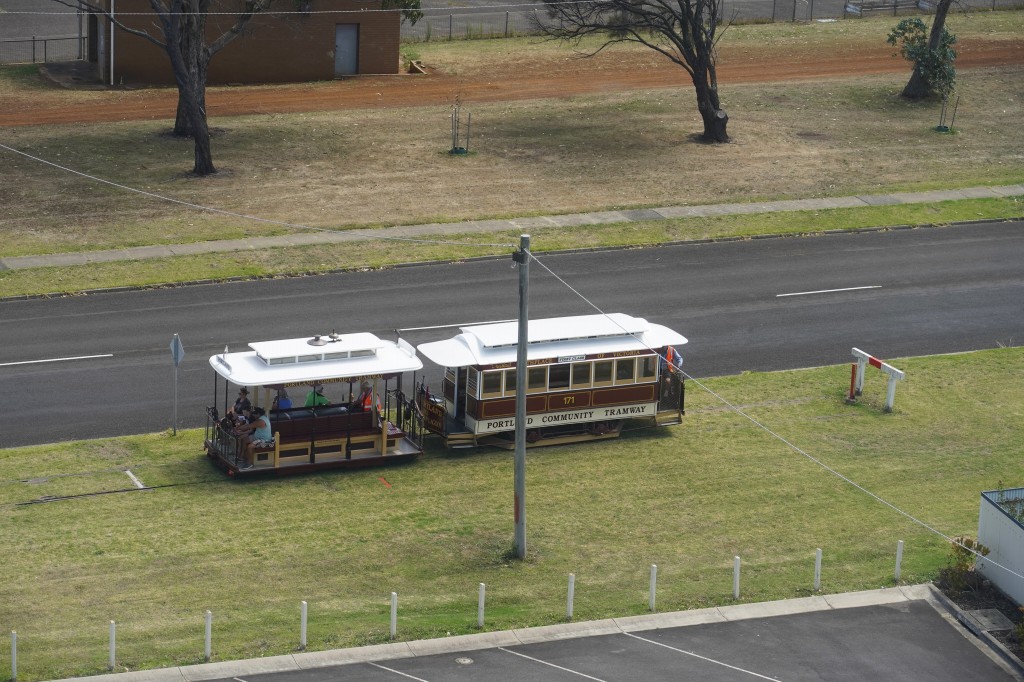
シャンティングトライアングルエンド線を使用して方向転換するトラム。
一旦タワールックアウト駅に到着したトラムは一旦バックし、後退時を除き常にグリップカーを先頭に走ります。
Trams change direction using the Chanting Triangle End line.
Once the tram arrives at Tower Lookout Station, it backs up and always runs with the grip car in the lead, except when backing up.
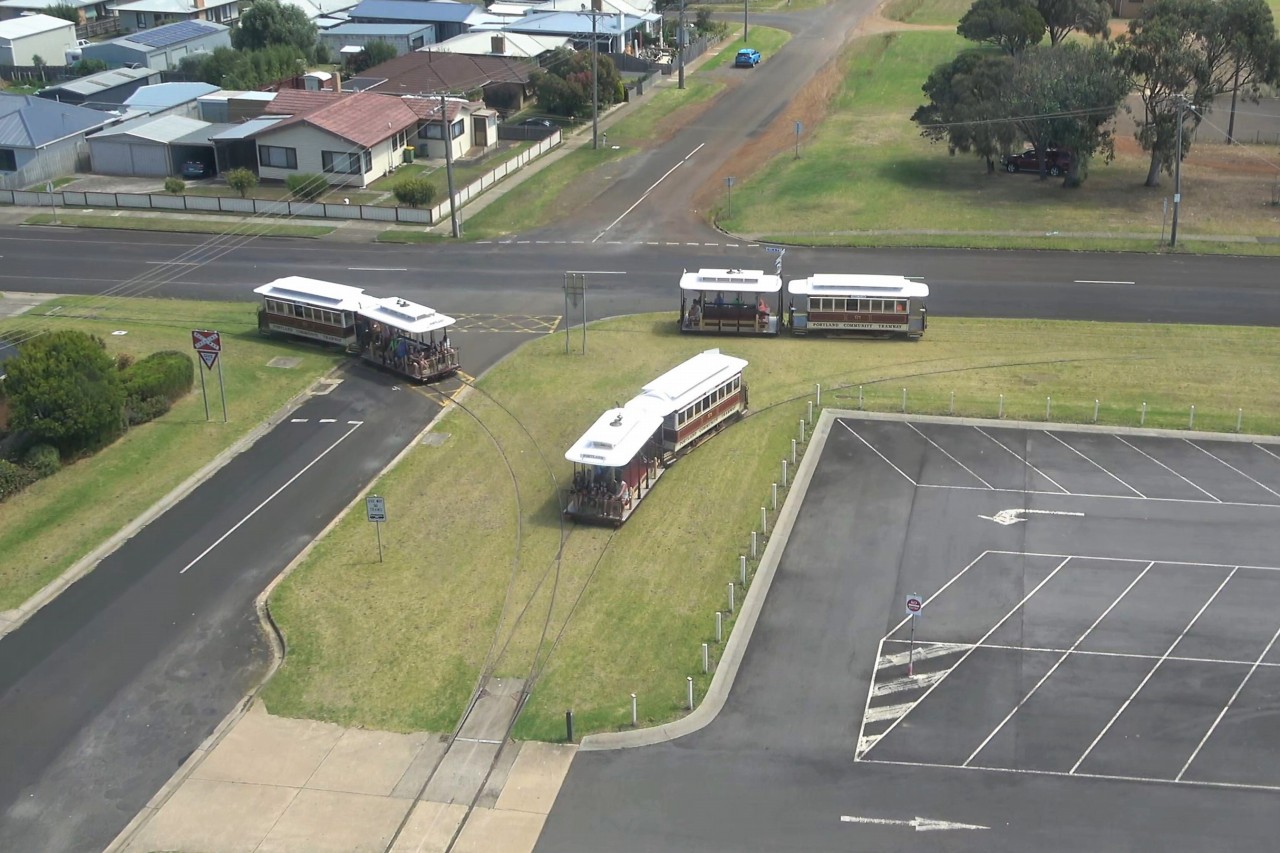
シャンティングトライアングルエンド線を走るトラムを時間差で合成写真にしました。
Time-lagged composite photo of trams running on the Chanting Triangle End line.
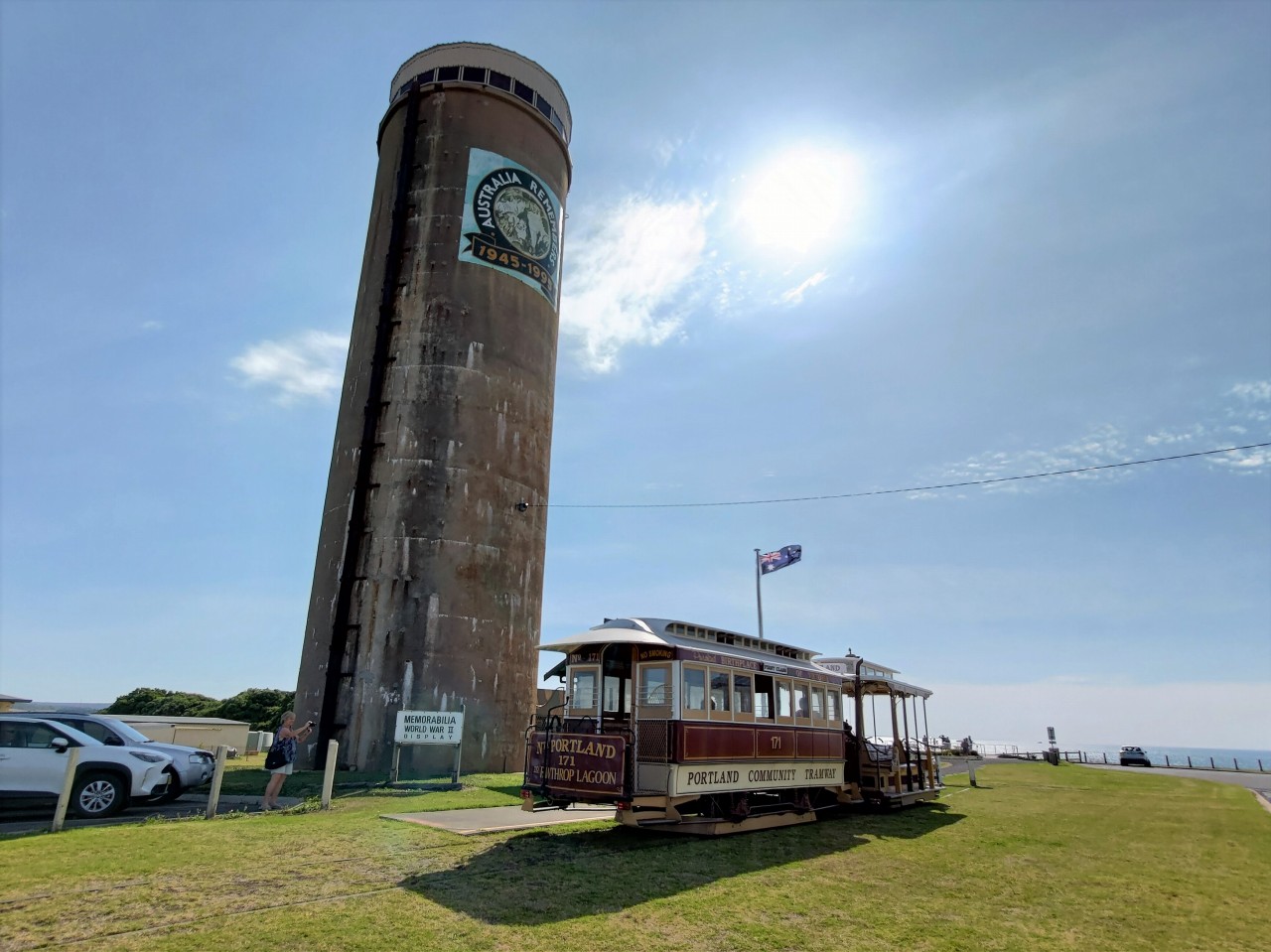
灼熱の展望フロアのタワーから外に出ると、爽やかな海風が体を冷やしてくれました。
その日のうちにメルボルンへ帰れるバスに乗るためには、トラムデポに帰る最終便よりも早くここを離れなければなりません。
A refreshing sea breeze cooled me as I stepped out of the tower on the scorching observation floor.
In order to catch the bus back to Melbourne by the end of the day, I have to leave here earlier than the last train back to the tram depot station.
ポートランドケーブルトラムの4Kキャブビュー映像です。
始発のトラムデポ駅を発車したトラムはパワーハウスミュージアム駅をバルーンループで抜け、終点のタワールックアウト駅でシャンティングトライアングルエンド線を使用し、再びトラムデポ駅へ帰ってきます。
ポートランドケーブルトラムは世界一手軽にキャブビューが楽しめる鉄道です。
4K cab view footage of the Portland Cable Tram.
The tram departs from Tram Depot station at the start of the line, goes through the Powerhouse Museum station on a balloon loop, then uses the Chanting Triangle End line at the end of the line at Tower Lookout station, before returning to Tram Depot station again.
The Portland Cable Tram is the world's easiest cab-view railway.
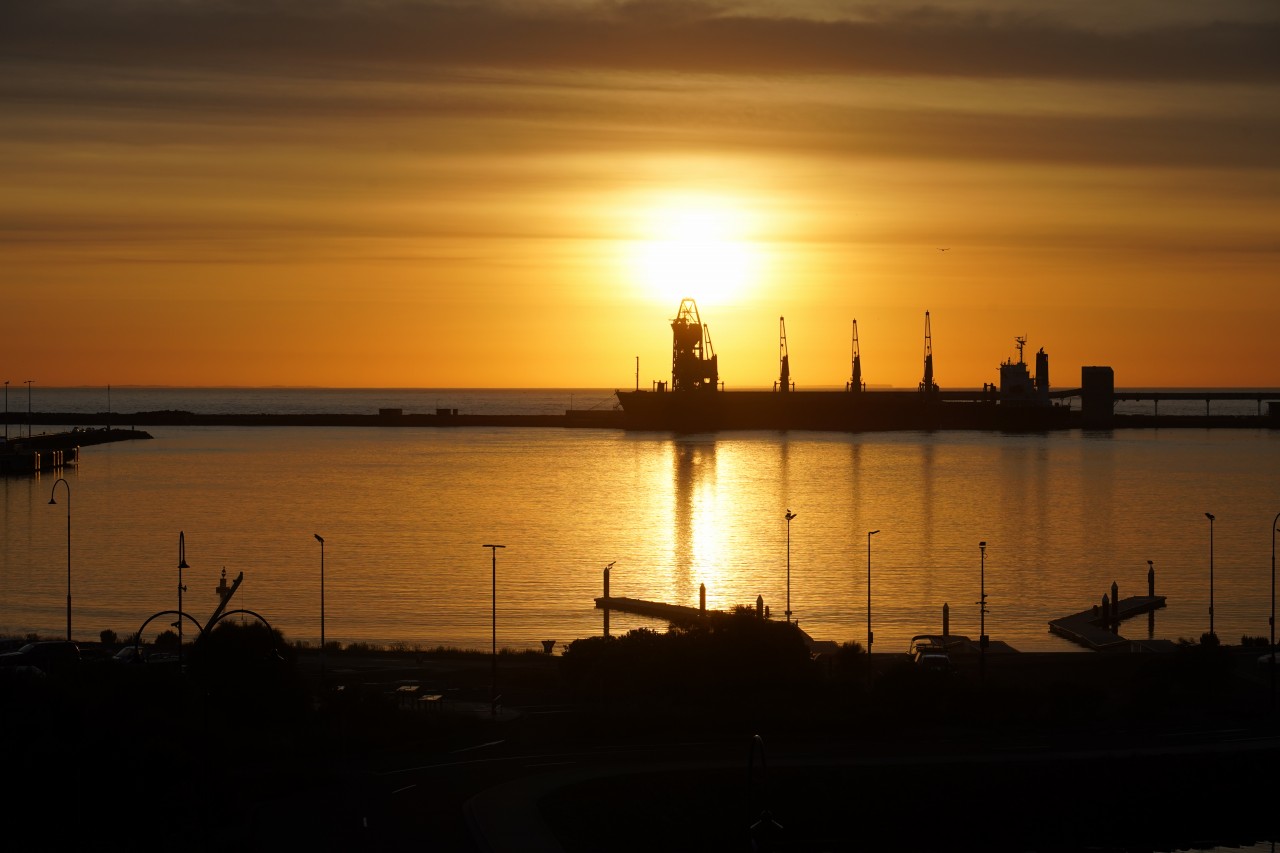
ポートランドは有名観光地グレートオーシャンロードからも近い、美しい港町です。
ここに宿泊すれば、朝は海から登る日の出をみることができます。
Portland is a beautiful harbour town, close to the famous tourist destination Great Ocean Road.
Stay here and you can watch the sunrise over the ocean in the morning.
---PR---
